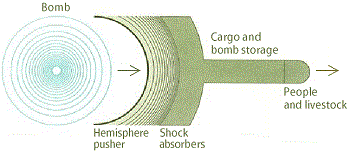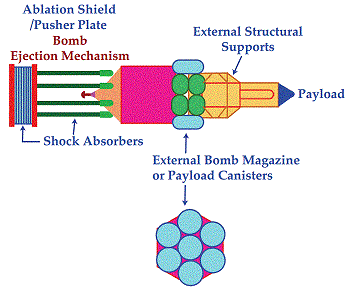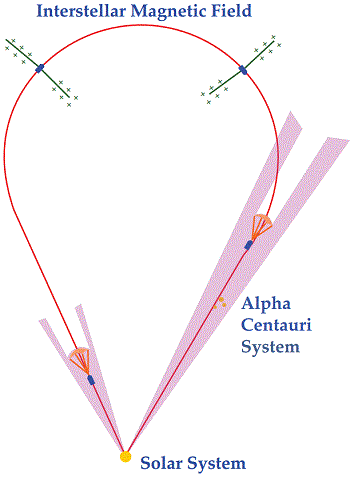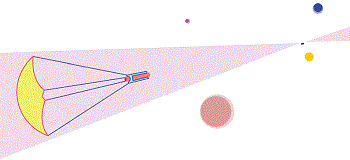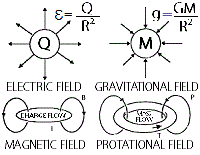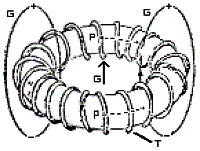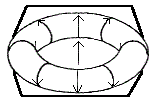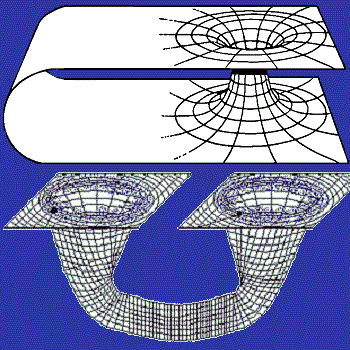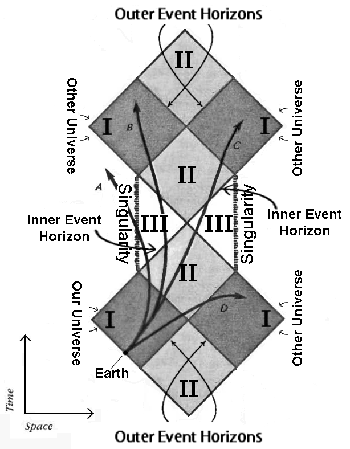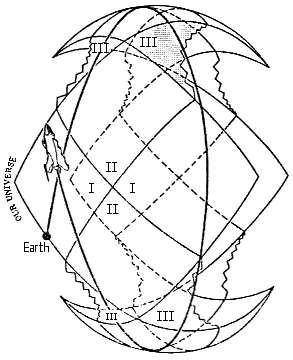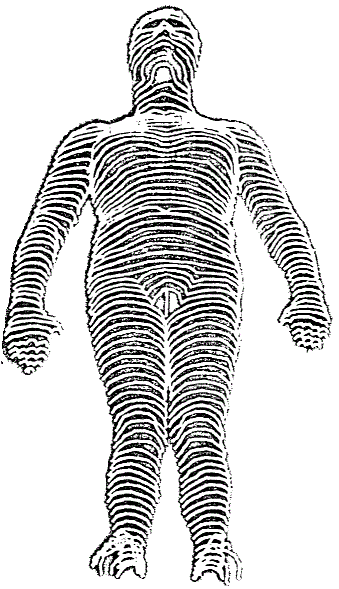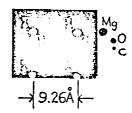© 1979 Robert A. Freitas Jr.
All Rights Reserved
 |
|
To a Type II stellar culture,
a mission to the stars will seem no more unreasonable nor expensive than Project Apollo or the Space Shuttle seemed to us. |
Many reputable Terran scientists have argued, or attempted to "prove," that starflight is impossible or at least grossly unfeasible. (See Asimov,1403 Morrison,2750 Oliver,2749 Opik,2748 Purcell,1024 Simons,2361 and von Hoerner,1025 to name just a few.)
However, in each case the only thing that was proven was that initial assumptions could be chosen to give the appearance of immense difficulty.
| Acceleration |
The fact is that without violating any of the principles of Einstein’s Theory of Relativity, an astronaut theoretically may travel anywhere in the known universe in less than a century — faster, if he can stand the acceleration. Strictly in accordance with the laws of physics as we understand them today, a physical object may be moved from any point A to any other distant point B in as short a period of time as is desired. If you have the energy, it’s just a problem in engineering.*
| Total energy resources |
As members of an emergent Type I civilization, we humans exhibit a natural tendency to measure the achievements of the future against the standards of the present and the limitations of the past. Dr. Edward Purcell, for example, has calculated that a 10-ton relativistic rocket traveling at 98% the speed of light over a 24 light-year round trip starcourse may require a propulsion system capable of handling 1018 watts of power. Since this is more than a hundred thousand times the current total output of humanity, such a proposition must be "preposterous"! Concludes Purcell, winner of the 1952 Nobel Prize in Physics: "All this stuff about traveling around the universe . . . belongs back where it came from, on the cereal box."
|
Strictly in accordance with the laws of physics
as we understand them today, a physical object may be moved from any point A to any other distant point B in as short a period of time as is desired. If you have the energy, it’s just a problem in engineering. |
| Matter of perspective |
But let us look at this a bit more closely. Is a 1018 watt starship really preposterous? Even an early Type II stellar culture will have 1020 watts at its command. Humanity itself may well achieve this state of affairs just a few hundred years from now. Is it logical to assert that we would begrudge a mere 1% of our total energy output for an interstellar mission? It seems useful to recall that the mighty Saturn V rocket booster that carried twelve American astronauts to the moon developed more than 1011 watts in its power plant — which represented roughly 2% of humanity’s total annual power output at the time.
It’s simply a matter of perspective. To a planetbound, 1013 watt developing Type I culture such as ours, a 1018 watt interstellar vehicle appears a fearsome project indeed. But to a 1020 watt early Type II stellar culture, a mission to the stars will seem no more unreasonable nor expensive than Project Apollo or the Space Shuttle seemed to us.
And to a mature Type II civilization (1026 watts), the dispatch of a 10-ton starship to neighboring stellar systems will represent the same relative drain on total energy resources as driving a Volkswagen automobile to market represents against the entire planetary power output of Earth.
* A complete bibliography of interstellar travel and communications has been compiled by Dr. Robert L. Forward.1680 Preliminary programs for interstellar exploration by mankind have been developed by Forward,718 Gillfillan,2845 Stine,672 and the Project Daedalus Study Group of the British Interplanetary Society.2953
 |
|
It is well-known that the equations of
Special Relativity (and other theories too) yield solutions for particles that go faster than light. |
|
There is a complementary
relationship between travel and communications: is the need for the other. |
Many scientists who might admit the possibility of starflight nevertheless question it on grounds of necessity. Why, they ask, should we or any other sentient race go to the trouble of transporting massive material structures from star to star when information about extraterrestrial intelligences can be gained much more cheaply by listening with radio waves? Indeed, notes Purcell, "a 10-word telegram can be transmitted over a 12 light-year path with a dollar’s worth of electrical energy."
| Tachyons |
And ET communications might not be limited to the speed of light, either. It is well-known that the equations of Special Relativity (and other theories too*) yield solutions for particles that go faster than light. These hypothetical particles, called "tachyons," have rest masses represented by "imaginary" numbers. Since no one could see how objects with "imaginary mass" could possibly exist, the solutions were long ignored.
Then, in 1962, Drs. O.M.P. Bilaniuk, V.K. Deshpande, and E.C.G. Sudarshan of the University of Rochester in New York reexamined the entire question. In their seminal paper "Meta-Relativity" they pointed out that if tachyons were always in motion, and at speeds perpetually faster than light, it wouldn’t matter what kind of number represented the mass. What really mattered was that tachyonic energy and momentum be "real" — which they are. According to the three physicists:
In classical mechanics the mass is a parameter which cannot be measured directly even for slow particles. Only energy and momentum, by virtue of their conservation in interactions, are measurable, therefore must be real. Thus the imaginary result for the rest mass of the {tachyon} offends only the traditional way of thinking, and not observable physics.1515
In recent times scientists have managed partially to resolve many of the apparent causality violations engendered by faster-than-light tachyons.
(See especially Antippa and Everett,1495,1477 Bilaniuk and Sudarshan,1516,1517 Feinberg,1492 Harwit,1478 Newton,645 Parmentola and Yee)1493 Recami and Mignani,1511 and Trefil.2026) Several experimentalists are now quietly searching for the controversial and elusive particles in what one describes as "a low key effort."646
| Transcendental tachyon |
Confirmation of the existence of tachyons would have dramatic implications in the field of interstellar communications. Normal matter as we know it, when propulsive energy is applied, goes faster. Tachyons, in contrast, are expected to speed up as they lose energy. At zero energy they should have infinite velocity, and be present everywhere (along a Great Circle route) in the physical universe at the same time. (This is called a "transcendental tachyon.") If tachyons exist, information could be transmitted between stars and even galaxies arbitrarily fast. Any location in the cosmos could remain in direct communicative contact with any other. With such a perfect means of communication, extraterrestrial races need never leave home and venture out into space.
|
Tachyon communication details Click for Synopsis
|
Conversely, let us imagine a civilization with perfect, instantaneous transportation. Any location in the physical universe can be reached in the blink of an eye. In such a society there may be no need for communications at all — it’s quicker just to travel. We see that there is a kind of complementary relationship between travel and communications: The better either is, the less is the need for the other.81
| One very critical difference |
There is, however, one very critical difference. A single party may engage in travel, but it takes two parties to communicate. If alien societies are to talk, both communicants and recipients must exist. Yet either can launch an interstellar exploratory mission without any knowledge of the other. Furthermore, if extraterrestrial cultures are to communicate, each must make a series of correct assumptions about the motivations, psychologies, and technologies of the others in order to be successful. Interstellar exploration by starship, on the other hand, requires no such ad hoc assumptions to succeed.
There are many other reasons why xenologists have concluded that interstellar travel is the preferred mode for first contact and galactic unification. Communication by radio does not permit contact between an advanced society and one that is intelligent but is not in possession of electronic technology. Such a culture need not necessarily be "unlikely to be of interest to us" as asserted by some radioastronomers. Aliens without radio may have other forms of technology — biological, chemical, social, economic — that would be fascinating to observe and yet do not involve electromagnetic radiation. As Arthur C. Clarke says, only starflight makes it possible "to gain knowledge of star systems which lack garrulous, radio-equipped inhabitants."2731
|
If alien societies are to talk, both
communicants and recipients must exist. Yet either can launch an interstellar exploratory mission without anyknowledge of the other. Aliens without radio may have other
forms of technology — social, economic, biological, chemical — that would be fascinating to observe and yet do not involve electromagnetic radiation. |
Interstellar travel also would allow:
- the exchange of artifacts and biological specimens
- direct observation of a multitude of independent biologies and societies
- the making of symbolic gestures of sociopolitical and cultural community
The sciences of astronomy and astrophysics would prosper. Direct astronomical samplings could be made of:
- stars in various stages of evolution
- distant planetary systems
- ancient globular clusters
- interstellar gas clouds
Cooperative scientific ventures could be undertaken with other races, such as performing trigonometric parallax experiments on extremely distant objects. And direct contact is probably the most effective way to achieve a meeting of minds between beings with utterly different histories and ways of thought.1317
* In one mathematical model of particle motion in a special five-dimensional space-time, velocities as high as 1021 times the speed of light appear possible.2893
|
So we see that galactic and intergalactic commerce
and tourism are very real possibilities for advanced extraterrestrial societies. a Type II culture, or a high-acceleration intergalactic cargo transport vehicle by a Type III culture, represents about the same allocation of energy and resources as the launching of a Saturn V rocket by human Type I civilization. |
|
Light-speed jargon Click for Synopsis
|
Alien and human astronauts alike must conform to the dictates of Relativity when traveling at velocities near the speed of light. Einstein’s theory, generally accepted today by the scientific community, predicts a host of fascinating consequences of near-lightspeed voyages.
First, we should briefly mention some of the jargon commonly employed by physicists and writers in this field. Relativity predicts that no material object can be accelerated up to the speed of light without an expenditure of an infinite amount of energy. Since the entire universe contains only 1081 joules of energy, attaining the speed of light becomes a practical impossibility. The velocity of light, designated as "c", this is a kind of "cosmic speed limit" imposed on all material objects within the physical universe. (Other jargon for c includes "100 psol" or percent-speed-of-light, and "Mike 1.0" after Dr. Albert A. Michelson.) Velocities below c are referred to as "suboptic" or "subluminal"; those faster than light are called "FTL," "hyperoptic" or "superluminal." The speed of light itself is "optic velocity."
| Twin Paradox |
Now back to the fascinating consequences. According to Relativity theory, time passes more slowly at near-optic velocities than at low suboptic ones. This apparent breach of common sense is traditionally presented in the form of a paradox. Imagine twin brothers A and B. A becomes an astronaut and flies away in a relativistic starcraft capable of a peak velocity of 98%c. B stays behind on Earth. A travels 12 light-years out into space, and then 12 light-years back to Earth. Because A has been moving slower than light, B must wait a total of 28 years for his return. B is thus 28 years older than his age when the brothers parted. But when he meets A in the Debarkation Area, A has only aged 10 years. A is 18 years younger than his identical twin.
This unusual consequence of near-optic flight, often called the Twin Paradox, has been confirmed indirectly by scores of experiments over the past half-century. There is little doubt in the minds of most physicists that the Paradox is a correct prediction of the consequences of traveling close to the speed of light. The contraction of time at high velocities is known as the phenomenon of time dilation.
|
Table 17.1 Effective FTL Starflight Using Relativity Theory |
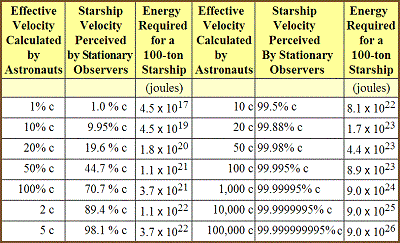 |
|
An astronaut, provided his starcraft has
sufficient energy, can effectively travel faster than the speed of light relative to a stationary frame of reference! |
The frame of reference of the observer is of critical significance here. Those observers who remain at rest with respect to the universe at large (such as the twin who stays on Earth) will always observe a relativistic starcraft to travel at suboptic velocities. But to the astronauts on board the spaceship, the contraction of distance between the points of origin and destination (another peculiar consequence of Relativity theory) will make the trip seem shorter. They will, from their frame of reference, actually be moving at a faster apparent velocity than that perceived by stationary observers (say, back on Earth). In fact, when the starship reaches exactly 70.7%c as measured by stationary observers, the astronauts calculate their own effective velocity as 100%c! As acceleration continues still further, shipboard-determined speed increases to seemingly hyperoptic velocities (which Earthbound observers still see as suboptic from their frame of reference).
|
Table 17.2 Duration of Interstellar Travels, Using a Standard Flight Plan at One Gee Acceleration |
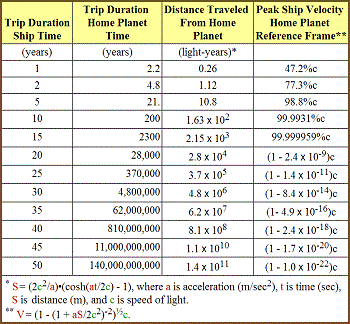 |
|
The Standard Flight Plan Click for Synopsis
|
What does all this mean in plain English? Simply this: An astronaut, provided his starcraft has sufficient energy, can effectively travel faster than the speed of light relative to a stationary frame of reference! (See Table 17.1 for details.)
Time dilation permits very long journeys within a single human lifetime. Consider a starship that accelerates uniformly to the midpoint of the trip and then decelerates uniformly at the same rate the rest of the way to the destination — called the Standard Flight Plan.
|
With 1 gee acceleration Ship-time required for voyage:
|
With an acceleration of 1 gee — appropriate for inhabitants of terrestrial worlds similar to Earth — only a few years of ship-time are required to reach the nearest stars. (See Table 17.2.) Only 21 years are spent reaching the Galactic Core, and in 28 years of shipboard time the intrepid explorers can visit Galaxy Andromeda in person. Since Andromeda is about 1.7 million light-years distant, this works out to a mean effective velocity of 61,000 times the speed of light.
| Twin Paradox with a vengeance! |
Of course, there is no time dilation on the home planet — since it went nowhere. If our intergalactic astronauts turned around at Andromeda and immediately returned to Earth, they would have aged a total of 56 years. The Earth and all of its inhabitants, however, would have aged 3.4 million years. This is a "twin paradox" with a vengeance!
|
Table 17.3 Acceleration Required to Complete Journey in One Decade Shipboard Time, Using Standard Flight Plan |
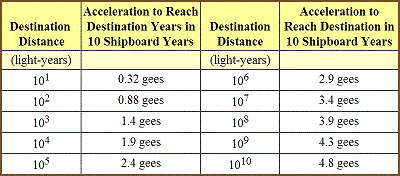 |
|
Relativity does permit effectively |
When science fiction writers and others speak of "FTL" they are usually referring to true (rather than "effective") FTL — that is, faster-than-light travel from the point of view of both astronauts and stay-at-homers. We shall discuss the theoretical possibility of true FTL later in this chapter. But for now it is important only to realize that Relativity does permit effectively hyperoptic interstellar journeying, at least from the standpoint of an astronaut setting forth to explore the universe.
This fact is highlighted by the data shown in Table 17.3. It is assumed that an astronaut wishes to travel a certain distance out into space, but he doesn’t want to use up more than 10 years of his life in getting there. Table 17.3 lists the starship accelerations that must be sustained throughout the entire trip in order to arrive at a destination at the specified distance within exactly one decade as measured on the astronaut’s own wristwatch. A Standard Flight Plan is assumed.
Note that any point in our Milky Way galaxy can be reached in ten years of shipboard time, at accelerations tolerable to human beings for long periods of time. Accelerations of 2-4 gees, perhaps sustainable by inhabitants of jovian or heavy subjovian worlds, or by bioneered former inhabitants of terrestrial worlds, would put the entire known universe within 10 years reach.
|
The levels of power expenditure needed
to achieve the benefits of relativistic time dilation are enormous by today’s standards. |
Naturally, the faster a starship is pushed the more energy is required. The levels of power expenditure needed to achieve the benefits of relativistic time dilation are enormous by today’s standards, even for fairly small vehicles. (See Table 17.1.) But as we shall see presently, this by no means bars interstellar or intergalactic commerce. Indeed, such commerce should be commonplace among Type II and Type III civilizations.
Let us consider three illustrative classes of starflight missions:
- 1. Interstellar personnel transport;
- 2. Intergalactic personnel transport;
- 3. Intergalactic cargo transport.
|
Relative energy costs (REC) Click for Synopsis
|
| Big and costly |
Too many writers have succumbed to the Fallacy of the Big and the Costly. That is, if it’s big and it costs a lot, it must be impossible. The Fallacy lies in the simple observation that what seems big and costly to one culture may be negligible and cheap to another.
| Saturn V rocket |
The relative costs of missions to the stars may perhaps best be appreciated by a comparison with the familiar. Humanity has launched about ten Saturn V rocket boosters to date. Each of these blustering behemoths developed 1.3 × 1011 watts of power for about 150 seconds each. This is the equivalent of harnessing the entire human energy output for exactly 4 seconds. Keep this quantity in mind as we work through the following examples: One Saturn V equals 4 seconds of humanity’s aggregate power output.
|
REC of interstellar personnel transport Click for Synopsis
|
| Interstellar personnel transport |
First we consider the interstellar personnel transport mission. We assume a flight distance of 100 light-years, appropriate for short hops between neighboring Type II civilizations. To make things comfortable for the pilots and passengers, we further assume a Standard Flight Plan at a constant 1 gee acceleration. Using the equations of Special Relativity, total trip time works out to a mere 9 years.
How much energy is required? If we take the mass of the vessel to equal that of the Starship Enterprise of original-series Star Trek fame (190,000 metric tons), then about 9 × 1026 joules of energy are required for the mission. A mature Type II civilization, having 1026 watts (joules/sec) at its disposal, should have no trouble with this at all. The interstellar personnel transport mission uses only nine seconds of the culture’s total power output, a feat equivalent in stature to the launching of two Saturn V rockets by modern human engineers. For a Type III civilization, this mission is inordinately trivial. In fact, roughly 44 billion such starliner missions could be dispatched if only 4 seconds of the galactic society’s aggregate energy output were utilized — a feat comparable to the launching of a single Saturn V from Earth today.
|
REC of intergalactic personnel transport Click for Synopsis
|
| Intergalactic personnel transport |
What about our second class of starflight mission — the intergalactic personnel transport? These are somewhat more difficult, probably well out of reach of a lone Type II civilization. Again, using a Standard Flight Plan at 1 gee acceleration to keep crew and passengers at ease, a trip of 1.7 million light-years to Galaxy Andromeda (the nearest giant spiral) would require only 28 years shipboard time. Approximately 1.5 × 1031 joules would be consumed making the journey.
Such a mission would tax the resources of Type II culture to the breaking point. More than 41 hours of the stellar society’s power output would be needed to launch a single intergalactic starliner, a feat analogous to the firing of 38,000 Saturn V’s by present-day humankind. Such an enormous sacrifice and commitment of resources would require some overwhelmingly compelling purpose to justify it.
For a mature Type III galactic civilization with 1037 watts under its control, however, the intergalactic personnel transport mission would again prove utterly trivial. Such a culture could launch more than 2.5 million such sorties to Galaxy Andromeda for a mere 4 seconds worth of its total power output — again, a feat comparable to our launching a single Saturn V rocket.
|
REC of intergalactic cargo transport Click for Synopsis
|
| Intergalactic cargo transport |
Finally, we consider the case of the intergalactic cargo transport mission. Since these ships can be unmanned, far higher accelerations may be tolerable. We assume a robot-controlled, 190,000-metric-ton cargo ship, dispatched to Andromeda at an acceleration of 106 gees (probably the upper limit for normal physical materials) on a Standard Flight Plan. Fortunately, the shipboard time of flight is only 1724 seconds, a bit under half an hour, so the ship and its contents are subject to extreme forces only for a very brief period of time. A total of 1.5 × 1037 joules are required for the mission, about 1½ seconds of the aggregate power output of a galactic culture. To a Type III civilization, the launching of two such high-acceleration cargo vessels requires a resource commitment equivalent to the launching of one Saturn V by human technologists.
So we see that galactic and intergalactic commerce and tourism are very real possibilities for advanced extraterrestrial societies. The dispatch of an interstellar personnel carrier by a Type II culture, or a high-acceleration intergalactic cargo transport vehicle by a Type III culture, represents about the same allocation of energy and resources as the launching of a Saturn V rocket by human Type I civilization.
 |
|
Requirements for starflight:
|
Three fundamental requirements must be satisfied if starflight is to be considered plausible for alien or human civilizations. First, the kinematics must be right. Second, the energy available for the mission must be sufficient. Third, there must exist an astronautic technology capable of performing the requisite kinematics using the available energy. In the preceding section we saw that the kinematic and energetic requirements are satisfied by Type II and Type III civilizations operating within the bounds of Einsteinian Relativity theory. For the remainder of this chapter the third requirement is examined in more detail — the technological aspects of interstellar voyaging.
| Four stages of technical progress |
Consider the nature of technical progress. There is an orderly progression from the emergence of new ideas, further research and development, then finally a reduction to practice and economic exploitation. Thus, the realization of new technology normally proceeds in four stages:
|
Matching this progression against current human
achievements, we find that radio, television, computers, automobiles, and chemical rockets all have arrived at the profit stage here on Earth. SSTs, and fission propulsion rockets are at the practice stage, awaiting full societal and economic commitment to move them into the profit stage. are presently in transition from theory to practice. |
- Stage 1 — IDEA — the basic philosophical idea, discovery of a new physical law, a new branch of mathematics, a new possibility within the existing framework of science.
(See Hogan2916 for an excellent example of this in science fiction.) - Stage 2 — THEORY — development of the mathematical/physical theoretical framework which ties the new idea to other known phenomena.
- Stage 3 — PRACTICE — research and engineering; building a device which utilizes the new idea in its manufacture or operation.
- Stage 4 — PROFIT — social, political, and economic acceptance and exploitation; who pays for it, is it worth the effort, who will benefit, etc.?
Matching this progression against current human achievements, we find that radio, television, computers, automobiles, and chemical rockets all have arrived at the profit stage here on Earth. Such advanced technologies as nuclear power planets, SSTs, and fission propulsion rockets are at the practice stage, awaiting full societal and economic commitment to move them into the profit stage. Laser fusion and satellite solar power stations are presently in transition from theory to practice.
The five conventional interstellar propulsion systems described in this section are all at the theory stage in human technological development. Each has received sufficient study to tell us that they have the basic physical and energetic feasibility to be considered for missions to the stars. All retain a number of technical uncertainties which will require significant engineering effort to overcome. Nevertheless, xenologists expect that all five propulsion systems are likely to advance at least to the practice stage within a century or less on this planet. So it is likely that these same systems also accurately represent the interstellar transport technologies of many extraterrestrial sentient races in the universe.
A sixth conventional interstellar propulsion system employing paired high-energy mass drivers for efficiently transporting massive cargoes between distant stars is briefly described in Section 21.4.1.
|
|
Nuclear pulse vehicle Click for Synopsis
|
In the 19th century Hermann Ganswindt proposed the use of a series of gun powder charges behind a vessel to propel it into space.2762 The concept of nuclear pulse propulsion, the modern extension of this basic idea, was developed under USAF contract at Gulf General Atomic during the years 1958-1965.
|
Project Orion Consists of five distinct parts:
|
| Project Orion |
Dubbed "Project Orion" by the scientists who worked on it, the system operates by tossing out a nuclear bomb, exploding it astern of the ship, and absorbing part of the momentum of the resulting debris. The rocket thus consists of at least five distinct parts: An hemispheric ablation shield or "pusher plate," an enormous shock absorber, a mechanism for ejecting the bombs, the bomb magazine, and finally the payload at the front end. Small test models using steel pusher plates and TNT charges were successfully flown during the experimental phase of Project Orion, but the work was shelved after the Nuclear Test Ban Treaty entered into force late in 1963. (The Treaty prohibits the explosion of nuclear devices in the atmosphere or in space.)
Freeman J. Dyson of the Institute for Advanced Study at Princeton, New Jersey, who worked on Project Orion, described a prototype model of a space vehicle utilizing the principle of nuclear pulse propulsion.476 His "Ablation Space Ship" has a total mass of 400,000 metric tons, consisting of 300,000 tons of one-megaton H-bombs (weighing 1000 kg each), 50,000 tons of structure and payload, and 50,000 tons of ablation shield. The pusher plate construction is such that about 30 meters/second forward velocity are imparted to the vessel with each explosion. A smooth 1-gee acceleration is maintained by the detonation of one bomb every three seconds, which requires a shock absorber stroke length of about 75 meters (Figure 17.1).
Dyson’s nuclear pulse vehicle exhausts its bomb supply in ten days, having reached a final velocity of 10,000 km/sec (about 3.3%c). The flight time from Earth to Proxima Centauri would then be 130 years for a simple flyby mission. For an encounter-capture mission the payload must be decelerated at the target, which more than doubles the time of flight for a vehicle of this size.
| Daedalus starprobe |
More efficient variants of the nuclear pulse technique have been suggested in recent times (Figure 17.2), particularly the idea of igniting tiny deuterium pellets instead of huge bombs behind the ship. Ignition would be achieved using pulsed laser beam fusion2751,2752 or heavy ion or electron beam fusion.2764 This latter technique has been selected for use in the Daedalus starprobe, an interstellar vehicle designed as part of a feasibility study sponsored by the British Interplanetary Society during 1975-1977.2953 In the Daedalus system, a 54,000-ton craft is propelled up to 12%c using a stream of frozen deuterium/helium-3 pellets which are zapped by a megavolt electron gun 250 times a second. The designers claim that the probe should be able to reach Proxima Centauri in 35 years with a 500-ton payload.2761
|
Montage of fusion-powered interplanetary spacecraft concepts from 1987-2004 (from Wikipedia) |
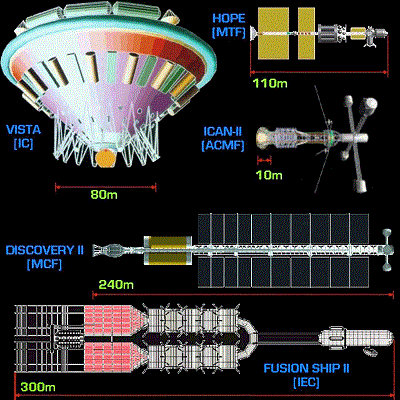 |
|
Theoretically, a fusion-powered |
Another highly promising starship propulsion system is the technique of using a controlled, continuous thermonuclear fusion reaction as the main power source. Because of the tremendous temperatures involved (upwards of 10,000,000 K), no known material can physically contain a fusion reaction. Magnetic fields therefore must be used to contain, compress, and heat the plasma fusion fuel (hydrogen, deuterium, tritium, etc.). Scientists are currently engaged in designing and testing various "magnetic bottle" configurations strong enough to hold such an energetic plasma, in connection with electrical power generation at major fusion research facilities around the world.
| Magnetic bottle |
The biggest problem is to make the magnetic bottle leakproof enough so that fusion reactions occur in sufficient abundance for the process to become self-sustaining. In terms of propulsion, however, a leaky bottle is exactly what is required. Hot plasma, energized by fusion energy, streams rapidly from the site of the "leak" and produces the desired rocket thrust.
According to Dr. Robert L. Forward, Senior Scientist at Hughes Research Laboratories, a deuterium fusion rocket capable of a steady 1-gee acceleration and consisting 90% of fuel (by mass) could reach a final velocity of 10%c.718 This would mean a travel time to Proxima Centauri of 45 years. Theoretically, a fusion-powered starship could be fueled by hydrogen isotopes drained from the atmosphere of Jupiter or from the icy rings of Saturn, and writer Alan Bond has estimated that a 10 light-year mission could be completed in 60 years.1159
| Waste X-rays |
One major problem to be overcome from a practical standpoint is to learn how to deal with the various forms of energy released by a fusion engine. Only about 20% of the energy liberated by nuclear reactions appears as kinetic energy — direct propulsive thrust — in the leaking plasma stream. Ten percent is thrown off as heat and ultraviolet radiation, but the lion’s share (70%) is released as X-rays. G.L. Matloff and H.H. Chiu have suggested that this energy may be reclaimed by using an auxiliary laser thruster surrounding the fusion reaction chamber.2754 Waste X-rays, absorbed by, say, xenon-doped gas in the laser, are converted into a collimated light beam which serves as a photon thruster.*
| Futuristic propulsive energy systems |
* A wide variety of related but "futuristic" propulsive energy systems may be possible. These may include:
- Condensed cold neutron reactions
- Pion fusion (which has been demonstrated experimentally)
- Muon catalysis fusion,2737
- Hawking black hole induced fusion1947
- Compact monopole fusor and energy storage devices or magnetic monopole metamatter.1224
- Fission rockets are not ruled out2758
- High-energy superpropellants such as monatomic hydrogen, metallic hydrogen,2684 cryogenic metastable triplet helium (stores 0.5 megajoule/gram) may be available.2736
|
Figure 17.3 Bussard Interstellar Ramjet2812 |
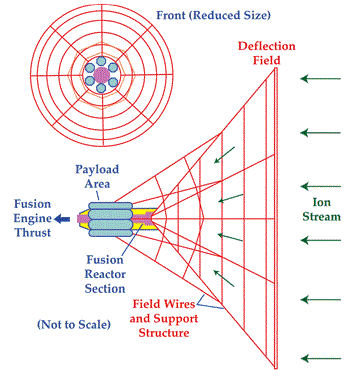 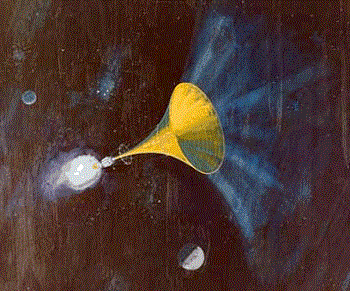 |
|
The Bussard ramjet is perhaps the
most intensively scrutinized potential interstellar propulsion system. |
The interstellar ramjet, first proposed by Dr. Robert W. Bussard at Los Alamos Scientific Laboratory in 1960, is a propulsion system which acquires energy and reaction mass from the surrounding medium.2766 Using some combination of electric and magnetic fields, the ramjet scoops up ionized interstellar gases to fuel its fusion rockets. This eliminates the need to carry large masses of fuel on board. Conventional chemical or nuclear rockets must be used to accelerate the starrammer up to about l-5%c, the threshold velocity at which the ramscoop mechanism becomes reasonably efficient.
The forward scoop would be immense (Figure 17.3). Bussard originally calculated that a 1000-ton vehicle would require a funnel diameter of 3600 kilometers to achieve a one-gee acceleration in normal interstellar space (~1 H-atom/cm3). In regions of dense hydrogen clouds, with perhaps 103 atoms/cm3, the ramscoop diameter could be as small as 120 kilometers. Theoretically, the acceleration could be maintained indefinitely, making possible the circumnavigation of the entire universe in less than a human lifetime.2755
Such monstrous scoops, of course, need not be constructed of physical materials. Most probably electromagnetic fields will suffice. To generate such fields, A.J. Fennelly of Yeshiva University and G.L. Matloff of the Polytechnic Institute of New York proposed in 1974 an annular copper cylinder coated with a layer of superconducting tin-niobium alloy (Nb3Sn).1454 The device would be rather modest in size (as starships go), measuring 400 meters in length and 800 meters in diameter. Energized with electrical current, an electromagnetic scoop with an effective diameter of 104 kilometers would be generated. For braking at the destination, a drogue chute made of boron (noted for its high melting point) about 10 km in diameter is recommended. (An electrically charged wire mesh would give sufficient drag without being destroyed by erosion.1066,1061)
As if to underscore the tremendous engineering difficulties involved in scoop design, Fennelly and Matloff announced in 1976 their original device was simplistic and probably would not work:
It is not possible, we have found, to design such a scoop. The {forces} induced … stress a scoop beyond the elastic limit of the substrate material and shear the superconductor to such an extent that it will be driven to a normally resistive state, with a subsequent catastrophe from the almost instantaneous Joule heating.1615
Nevertheless, assert the authors gamely, "we have hope that further analysis will lead to feasible scoop designs with some type of electromagnetic field to give a large scoop effective radius." It is now believed that a mixed electrostatic/electromagnetic field design will give the best results. (See Matloff,2759 Matloff and Fennelly,2766 and Powell.2760)
By adding "wings" to the starrammer, travel times may be cut in half.2782 Explains one writer:
The wings are two great superconducting batteries, each a kilometer square. Cutting the lines of the galactic magnetic field, they generate voltages which can be tapped for exhaust acceleration, for magnetic bottle containers for the power reaction, and for inboard electricity. With thrust shut off, they act as auxiliary brakes, much shortening the deceleration period. When power is drawn at different rates on either side, they provide maneuverability — majestically slow, but sufficient — almost as if they were huge oars.2180
| Collateral design and operational problems |
The Bussard ramjet is perhaps the most intensively scrutinized potential interstellar propulsion system. As a result, scientists are beginning to call attention to collateral problems involved in the design and operation of ramscoop vehicles.1155 One objection voiced by John Fishback in 1969 is fundamental.1461 He points out that the section of the starship which contains the sources of the magnetic scoop fields must be strong enough to withstand the forces generated by those fields. As the starcraft goes faster and faster, the required field strengths also increase. Since materials are limited by their maximum tensile strength, at some point the acceleration of the vehicle will have to be reduced to avoid the breakdown of its structure caused by the pressure of magnetic forces.1462
For realistic building materials, this cut-off velocity at which further acceleration must be drastically curtailed occurs at about 99.999998%c. This is high enough to be of no practical significance for galactic travel at 1 gee, but may prove restrictive for higher acceleration rammers or for starships on intergalactic missions.
|
Micron-sized frozen deuterium pellets
are accelerated electrostatically or electromagnetically out into space several years prior to the launching of a standard Bussard ramjet having a comparatively small scoop cross-section (perhaps it would be just a simple physical structure, such as a giant funnel). concentrated fuel en route simply by staying on the "runway." |
| Finicky hydrogen |
Another major difficulty, noted by Bussard and many others since, is that the proton-proton nuclear reaction is a poor candidate for fusion rockets. Most of the gas likely to be scooped up by the interstellar ramjet will be ordinary hydrogen, and hydrogen is very finicky when it comes to fusion. Deuterium reactions have a cross-section roughly twenty orders of magnitude greater, but this heavy isotope of hydrogen is relatively rare in the interstellar medium.
| Catalytic nuclear ramjet |
Recently, Daniel P. Whitmire has suggested the concept of a catalytic nuclear ramjet to overcome this problem.1471 In Whitmire’s scheme, the starship would carry on board a supply of "nuclear catalyst" consisting of carbon, nitrogen, and oxygen atoms. This fuel additive should catalyze a vastly increased reaction rate among ordinary hydrogen atoms without itself being consumed. Calculations indicate that this technique will yield a rate of fusion more reasonable from the standpoint of interstellar missions. For this scheme to succeed, of course, a workable heavy ion fusion reactor must be developed, but, in Whitmire’s words, "the difficulty seems to be of a technological rather than fundamental nature." (He also proposes the use of a bank of forward lasers to ionize neutral atoms approaching the rammer’s maw, thus greatly increasing the reaction mass available for the starship’s engines.)
| Ram Augmented Interstellar Ramjet |
An interesting hybrid variation of the basic ramscoop technique involves a vessel that carries its own nuclear fuel supply and exhausts the reaction products for thrust, much like a conventional fusion rocket. However, this Ram Augmented Interstellar Ramjet, or RAIR as Alan Bond of the British Aircraft Corporation calls his device, enhances its performance by scooping up atoms from the interstellar medium and using them as reaction mass rather than for energy generation.1455
In other words, fusion fuel is carried by the spaceship and additional reaction mass is collected from gas clouds through which the vessel passes. Preliminary calculations show that the RAIR design may save at least an order of magnitude of fuel savings at speeds up to 50%c, and as much as two orders of magnitude of fuel savings up to 70%c. Performance characteristics of RAIR starships have been worked out by Bond1455 and Powell.1117,1115,2769
| Fusion Ramjet Runway |
Two other fascinating variations on the interstellar ramjet have been proposed by Whitmire and A.A. Jackson IV.2733 The first of these is called the Fusion Ramjet Runway. Micron-sized frozen deuterium pellets are accelerated electrostatically or electromagnetically out into space several years prior to the launching of a standard Bussard ramjet having a comparatively small scoop cross-section (perhaps it would be just a simple physical structure, such as a giant funnel). The starrammer could then collect a more concentrated fuel en route simply by staying on the "runway."
| Stellar Ramjet |
The other suggestion, rather bizarre and considerably less likely, is the Stellar Ramjet. This vehicle accelerates up to near-optic velocity across the photosphere of a star. Whitmire and Jackson propose that the envelope of a red giant or a large protostar would be ideal for this technique. Accelerative forces would be large but not prohibitive, and biological crews should survive if they are somehow immobilized or "frozen" during the starship’s relatively brief period of acceleration.
|
|
It may be best to use an |
We have seen that it may be best to use an external source of energy to achieve near-optic speeds. The interstellar ramjet discussed above is a good example of this technique. Another possibility is the Laser Pushed Vehicle, or LPV.122,2767
The LPV obtains its energy and momentum from a solar-system-based laser network which pushes the ship by photon reflection from an onboard mirror. Calculations indicate that a power of roughly 1014 watts delivered to a 100-ton starship should be sufficient to impart a one-gee acceleration to the craft. Focusing would be of critical importance, and it may turn out that only x-rays will have a small enough wavelength/diameter ratio to forestall gross energy wastage. Upon arrival at a destination, LPV deceleration is effected in reverse fashion with the active assistance of the receiving civilization.22
What if there is no receiving civilization? Is the Laser Pushed Vehicle strictly limited to one-way flyby missions of exploration? The answer, apparently, is no.
According to Philip Norem, a space-based laser system could be used to accelerate a starprobe up to relativistic velocities. After a while, the craft extends long wires and charges them up to high voltage. These would interact with the Galactic magnetic field, swinging the LPV around in a slow, giant arc (Figure 17.4a). The course is chosen to aim back through the target star system, but on a general heading towards Earth. The wires are discharged and reeled in; the orbital laser network is turned on again, this time functioning to decelerate the starcraft.2756
Very large space-based laser arrays would be required to carry out such a mission, perhaps as big as 250 kilometers in diameter. These should be parked in close solar orbit, drawing their power directly from the high solar flux available there. For maximum efficiency, the LPV’s mirrored "sail" should be of a size comparable to that of the laser array — perhaps 250 km wide, weighing thousands of tons even if it is very thin. Surprisingly, the laser array energy flux need not be very high to push a vehicle to relativistic speeds. Typically the beam should be no more powerful than ordinary sunlight.
| Laser Powered Ramjet |
A proposed hybrid system combines the best qualities of the interstellar ramjet and the laser pushed vehicle and avoids many of their disadvantages. Called the Laser Powered Ramjet, or LPR, the starcraft obtains its power from a space-based laser network and its reaction mass from the interstellar medium using an electromagnetic ramscoop. The propulsion system is greatly simplified because the LPR does not require an onboard hydrogen-burning fusion reactor motor — since all power is furnished by laser beam. Calculations suggests that the LPR may be superior to the LPV under virtually all conditions. It should also outperform the Bussard ramjet at speeds below 14%c during the acceleration phase and
at all speeds during the deceleration phase of the mission.2733
| Laser Powered Rocket |
Whitmire and Jackson propose two additional alternative propulsion systems that appear promising. The first of these is the Laser Powered Rocket, which differs from the LPR because it carries along its own reaction mass onboard instead of gathering it from the interstellar medium. Extraordinary energy efficiency may be possible because the exhaust velocity is controllable.2733
| Particle Powered Ramjet |
The second possibility may be called the Particle Powered Ramjet, which obtains its reaction mass, its fuel, or both from space-based particle accelerators: After acceleration, the particles could be neutralized by the addition of electrons or positrons to avoid coulomb spreading of the beam. The neutral particle current required would be relatively modest — for antimatter, about 105 amps to produce 1014 watts on board at low velocities. The problem seems to be collimation since there is no particle analogue to the laser.2733
|
Table 17.4 Black Hole Power Generation and the Spontaneous Evaporation of Hawking Black Holes |
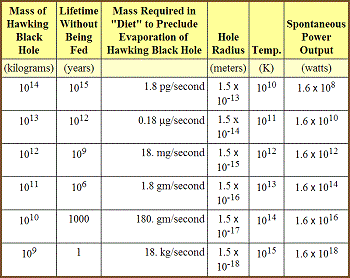 |
|
Bring together equal quantities
of matter and antimatter, allow annihilation or "total conversion" to take place, and then convert the products to useful thrust. |
| Antimatter propulsion |
The basic idea of using antimatter to power starships has been discussed in the technical and fictional literature for many decades. The most common system is the "photon drive"*: Simply bring together equal quantities of matter and antimatter, allow annihilation or "total conversion" to take place, and then convert the products to useful thrust. Gamma rays as well as high energy electrons and positrons are thrown off, but about half of the energy liberated is in the form of neutrinos which escape isotropically and are wasted.
The usual antimatter propulsion scheme thus amounts to no more than "partial conversion" with an efficiency well below 50%. Better results may perhaps be obtained by using cold or "frozen" positronium gas as fuel. Positronium consists of pseudo-atoms in which a negatively charged electron orbits a positively charged positron (the electron’s antiparticle) — this has been observed experimentally. As the fuel is warmed, electron and positron annihilate, producing a pure beam of gamma radiation. Eugene Sänger proposes using an electron gas reflector to focus and direct the photonic jet.2840 Alan Bond estimates that a million-ton starship with a mass ratio (fueled/unfueled, by weight) of 7.4 and an acceleration of one gee could reach 60%c.1159
Dr. D.D. Papailiou at Jet Propulsion Laboratory in Pasadena claims that for missions to nearby stars optic exhaust velocities are not necessary. A far more efficient technique is to use a small amount of antimatter to energize a large amount of ordinary matter. Preliminary calculations by Papailiou show that a mass ratio of 5.0 and a 2% charge of antimatter (by weight) is optimal to achieve a probe coast velocity of 33%c.2757
So if we wanted to launch a 10-ton starship on an encounter-capture mission, we must built a top stage of 51 tons — the 10-ton probe, 40 tons of ordinary matter, and 1 ton of antimatter — to obtain a mass ratio of 5. This stage serves to decelerate the probe at its destination. To get it there, we will need a 205-ton bottom stage — 200 tons of ordinary matter and 5 tons of antimatter — in order to accelerate the top stage up to 33%c. Delivery of a 10-ton space probe with a coasting speed of 33%c to another star system thus requires a total ship mass of about 256 tons, of which 6 tons are antimatter.
| Antimatter Ramjet |
A related scheme is the Antimatter Ramjet, which gathers normal matter in the forward scoop primarily as reaction mass. In a manner similar to Papailiou’s antimatter drive outlined above, interstellar matter would be commingled with bits of antimatter stored onboard. In this case the probe need only carry the requisite 6 tons of antimatter fuel when it leaves the planet of origin (perhaps stored in the form of frozen antihydrogen maintained a few degrees above absolute zero), and can pick up the remaining 240 tons of ordinary matter en route to its destination.
Many physicists object to the feasibility of total conversion drives such as those mentioned above because of the difficulty today of generating macroscopic quantities of antimatter. But the problems of creation and control should not prove insuperable. Writes Dr. Forward:
The present methods for producing antimatter involve the use of large accelerators which can produce a proton beam of 1015 protons per second. When such a beam collides with a target, antiprotons are produced as part of the debris. The antiproton yield of present machines is very low. However, the presently used methods are not designed for antimatter production but rather for studies in the physics of elementary particles. Rough calculations assuming special purpose high amperage colliding beam accelerators indicate that the generation of kilograms of antimatter per year is not out of the question. The containment and control of the antimatter, once made, should not be too difficult since we have a number of ways of applying forces to the antimatter without touching it. Electric fields, magnetic fields, rf fields and laser beams are all used in present day technology to levitate and control small amounts of regular matter that we do not want to contaminate. These would all be equally effective on antimatter.718
|
The Hawking Black Hole becomes a total
conversion engine when we start "feeding" it. simply by shoveling in raw matter — any matter — at an appropriate rate. an extremely high-efficiency photon drive propulsive system. an HBH in the first place. |
| Hawking Black Holes |
Another considerably more speculative total conversion system involves so-called Hawking Black Holes (HBHs). According to Dr. Stephen H. Hawking at the University of Cambridge, all black holes (if any exist) radiate energy due to quantum mechanical "tunneling" effects. This is equivalent to mass loss, so eventually the entire corpus of the black hole "evaporates." A stellar-mass BH is very "cold" — in fact, close to absolute zero — but a low-mass HBH is extremely "hot" and prone to explosive evaporation.2021 For instance, a million-ton HBH should radiate about 1018 watts at a temperature of about 1015 K, and will take about one year to finish evaporating.
The HBH becomes a total conversion engine when we start "feeding" it. Evaporation can be indefinitely postponed simply by shoveling in raw matter — any matter — at an appropriate rate (Table 17.4). Such a device could be used to construct an extremely high-efficiency photon drive propulsive system. The main problem is how to construct an HBH in the first place. Dr. John A. Wheeler estimates that a black hole of mass 109 kilograms might be generated artificially by the controlled thermonuclear fusion implosion of approximately 5 × 1013 kg of deuterium.2022 This involves the handling of some 5 × 1028 joules of energy, which looks like a job for an ambitious mature Type II civilization or an early Type III galactic society.
* Acceleration A (m/sec2) of a perfect photon rocket of mass M (kg) and power output P (watts) is given by: A = 2P/Mc, where c is the speed of light (3 × 108 m/sec).

The exotic interstellar propulsion systems discussed in this section are all at the "idea" stage in human technological development. There is no guarantee that any or all of them can be made to work. A few have some theoretical support, but many do not.
Nevertheless, xenologists deem them important because of the likelihood that some may have advanced to the "profit" stage of exploitation in at least a few extraterrestrial Type II or Type III technological civilizations.
|
A starship approaches a binary star
system whose members are both white dwarfs orbiting each other at close range. the proper trajectory, the starcraft benefits from gravitational slingshot or Newtonian "gravity whip" effect. from the stellar pair. The most speculative gravity machine
of all is the Smoke Ring Catapult, which consists of a rotating torus of dense matter (such as neutronium) turning inside out like a smoke ring. in the direction of the rotation, so a starship fired through the center of the massive hoop could be kicked up to very high velocities — depending upon the rotational energy of the torus. |
It is possible to conceive of "machines" that are capable of pushing a body, using gravitational force, up to fairly impressive suboptic velocities. These devices violate no known basic laws of physics, but it's difficult to see how to do the required engineering.
| Contact Binary Catapult |
The most "conventional" of these, first discussed by Freeman Dyson, has been called the Contact Binary Catapult.1023 A starship approaches a binary star system whose members are both white dwarfs orbiting each other at close range. By swinging in very near to one star on the proper trajectory, the starcraft benefits from gravitational slingshot or Newtonian "gravity whip" effect. The vessel withdraws orbital energy from the stellar pair.
Dyson estimates that a system involving two 1 Msun white dwarfs could accelerate delicate and fragile objects to a velocity of 0.7%c — at about 10,000 gees. Since there are no engines or propellants, there are no physical stresses on the payload — gravity acts on all parts of a material body equally. (Tidal forces, on the order of D/80 gees where D is starship diameter in meters, should not prove troublesome.)
Dyson also considered the possibility of using a pair of orbiting neutron stars as a gravity catapult. Unfortunately, they cannot exist! A neutron star binary would radiate away all of its orbital energy as gravitational radiation in less than 2 seconds. The two objects would coalesce almost immediately with a spectacular "gravity flash" at a frequency of about 200 Hz.
| Black Hole Catapult |
A more exotic technique is the Black Hole Catapult. This scheme requires that and find a rotating black hole (stellar mass) somewhere in space, then travel around it in the direction of spin very near to the equator. Besides losing a lot of time because of General Relativistic time dilation effects, some of the BH’s rotational energy would be converted to linear kinetic energy of the star ship. There would be a substantial increase in velocity. Tidal forces during transit will be rather extreme — about 500 million gees per meter — but apparently there are tricks with dense masses in a space vehicle that can be used to cancel the tides.2014 A Neutron Star Catapult is also possible, with similar effects.1099
| Smoke Ring Catapult |
The most speculative gravity machine of all is the Smoke Ring Catapult, which consists of a rotating torus of dense matter (such as neutronium) turning inside out like a smoke ring.2739 Relativity theory predicts a force in the direction of the rotation, so a starship fired through the center of the massive hoop could be kicked up to very high velocities — depending upon the rotational energy of the torus.
|
A negative mass at rest beside a positive
mass would begin to accelerate. mass (which repels all matter) would pus on the positive mass, but the positive mass (which attracts all matter) would pull on the negative mass. they will chase each other and will neither separate nor collide. since they each sum to zero. |
Over the years the theme of antigravity and inertialess propulsion systems have been widely discussed, mostly in the fictional or pseudoscientific literature.
- From H.G. Well’s cavorite gravity screen in his First Men in the Moon,
- To such questionable propositions as the Biefield-Brown effect,137
- Blackett’s Spin-Magnetic Coupling Theory1194 (which apparently inspired the late science fictioneer James Blish to write Cities in Flight with its "spindizzy drive"2809),
- F. B. Hli’s Theory of Electrogravitics (see the lively debate in Cashmore and Gordon,1197,1199 Hli,1196 Hli and Okress,1201 Johnson and Hli,1198 and Okress1202),
- Leonard G. Cramp’s G Field Theory,755
- And of course the infamous Dean Drive (see Adams,2859 Campbell,1361 Cuff,2773 Davis,1371 Jueneman,2807 Klotz et al,2772 Pournelle,2806 and Stine2771), the idea has enjoyed a colorful and vituperative history.
- A number of U.S. patents have been issued on supposed antigravity machines.2773
- Even Einstein himself spent the last thirty years of his life searching for a unified field theory that would relate gravity and electromagnetism, and the search continues apace today.2774
| Negative matter |
To construct a gravity screen would theoretically require the ability to achieve gravitational polarization of matter.16 This would imply the existence of two very different kinds of matter — positive mass, which is attracted towards the Earth, and negative mass, which is repelled. At one time it was believed that antimatter might turn out to have negative gravitational mass,2692 but most physicists would dispute this today.1314,2952
Yet the search for negative mass continues. So far as we know there is no experimental evidence for negative matter, although it does appear in several solutions to the field equations in General Relativity. Papers by A.K. Raychaudhuri1521 and R. Mignani and E. Recami1519 suggest that tachyons may experience a gravitational repulsion to ordinary mass and thus may be interpretable as "negative matter," although because of their imaginary masses they will still fall towards a positive mass.
Besides gravity shields, negative masses, if they exist, could be employed directly for propulsion. A negative mass at rest beside a positive mass would begin to accelerate. Why should this be so? The negative mass (which repels all matter) would push on the positive mass, but the positive mass (which attracts all matter) would pull on the negative mass1190 If the two objects "weigh" the same, they will chase each other and will neither separate nor collide. Energy and momentum is conserved, since they each sum to zero.
|
A related concept is the idea of inertia control.
■ Gravitational mass represents the force of gravity ■ Inertial mass represents the force of physical acceleration. the two kinds of mass are identical out to eleven decimal places. |
Presumably the negative mass could be created out of empty space if a positive mass of equal "weight" was created simultaneously. The net energy cost would be zero, since (-m)c2 + (+m)c2 = 0. To achieve reasonable starship accelerations, compact masses with densities like black holes should be used. Dr. Robert Forward elaborates:
What we really want to do is make a dense negative mass and a dense positive mass down in the engine room. We’d just pull them out of empty space, put a charge on the positive one and couple it with the spacecraft with electric fields. Now we have the two masses down in the engine room; they’re probably about 10-23 cm across and they weigh a little more than the spacecraft. The positive one is coupled to the spacecraft and the negative one pushes the positive one which pushes the spacecraft. Our vehicle’s acceleration can be as high as we can tolerate.2014
| Inertial mass |
A related concept is the idea of inertia control. Gravitational mass represents the force of gravity, and inertial mass represents the force of physical acceleration. The Eotvos experiment demonstrated that the two kinds of mass are identical out to eleven decimal places, under normal terrestrial conditions. But suppose we (or clever aliens) could arrange abnormal conditions which would allow the inertial mass of a chunk of matter to vary. When inertia is decreased, the same force imparts a higher acceleration; as inertial mass is brought close to zero, tiny forces would be able to produce huge accelerations. Lowering the inertial mass of fusion rocket propellant tanks would eliminate most of the normal constraints on lengthy interstellar missions for such vehicles.
Three other antigravity machines have been discussed by Robert Forward which involve no violations of the basic and established laws of physics (Figure 17.5).
| Special Relativistic Antigravity Machine |
The first of these, which he calls the Special Relativistic Antigravity Machine, involves a mathematical analogy between gravitational and electric fields.2740 A "linearization" of General Relativity gives a version of Newtonian mechanics which obeys Special Relativity. (Classical Newtonian mechanics does not.) In electromagnetism, something called charge is surrounded by a spherically symmetric electric field. In gravitation, something called mass is surrounded by a spherically symmetric gravity field. It may be said that the simple Newtonian gravity field is the gravitational analogue to the electric field.
| Lense-Thirring Effect |
The linearized General Relativity theory provides a similar analogy to magnetic fields. Much as a magnetic field is due to the motion of an electric charge or current flow, the linearized theory suggests that a moving mass, or "mass current," will give rise to a new kind of gravity field by a mechanism known as the "Lense-Thirring Effect."2890 Scientists plan to try to measure this field as it is produced by the rotating Earth in future satellite experiments.3320
Forward calls this new field a "protational field." He claims that, based on the existence of the field, an antigravity machine might theoretically be constructed in the shape of
…a torus with a tube wrapped around it, filled with very dense matter. If we started accelerating that mass flow through the tube around the torus, we would get a constantly increasing protational field, inside the torus. A changing protational field will create a gravity field just as a changing magnetic field will create an electric field. If we did it right, we would have an upward gravity field that could be used to cancel the field of the Earth.2014
| General Relativistic Antigravity Machine |
A second kind of antigravity machine suggested by Dr. Forward couples directly to "the fabric of space-time." His General Relativistic Antigravity Machine makes use of the notion that the presence of mass in a flat space-time causes a curvature, and that a rotating mass causes space-time to rotate too:
Imagine a rotating torus of dense mass, turning inside out like a smoke ring. An inside-out turning ring of very dense mass will create a force in the direction of the motion — a "dragging of the metric" as it is sometimes called. There will be general relativistic forces in the direction of the velocity of the mass. These forces are equivalent to a gravity field which again, theoretically, can be used to cancel the gravity field of the Earth.2014
And, as Willy Ley once pointed out, such a weightless body "would be squeezed out of the atmosphere by the weight of the air around it."2808
| Inertia Redistribution Antigravity Machine |
Finally, there is the Inertia Redistribution Antigravity Machine. The main principle behind inertia redistribution is the idea that inertia is a "tensor" quantity.2740 A tensor is just a multidimensional vector, so all this means is that we are accepting for the sake of argument the hypothesis that inertia may be a quality of matter that can be resolved into distinct directional components. That is, in our normal three-dimensional world, inertial mass becomes a three-dimensional quantity. While current experimental evidence does not support the tensor theory of inertia, if it is correct it leads to an interesting possibility for propulsion.
|
The main principle behind inertia redistribution
is the idea that inertia is a "tensor" quantity. so all this means is that we are accepting for the sake of argument the hypothesis that inertia may be a quality of matter that can be resolved into distinct directional components. inertial mass becomes a three-dimensional quantity. |
The Redistribution Machine does not get rid of inertial mass, but rather redistributes it so that some of it is pointing in new directions. If the machine makes the starship’s mass heavier in the horizontal plane and proportionately "lighter" in the vertical direction, a relatively tiny amount of force applied vertically would cause relatively large accelerations in that direction. The benefits are similar to those achieved using inertia control, discussed above, with the added advantage that inertia is conserved. (Note that since gravitational mass is unchanged, spacecraft will still feel the same attraction to planets and other massive bodies.)
Inertialess starships would have a number of interesting performance characteristics. Such a system must necessarily act upon every atom of the vessel in order to be effective. Far from any planet (so gravitational mass can be ignored), the inertialess craft could start and stop almost instantaneously. Since passengers have almost no inertia in the direction of flight, hideous accelerations can be tolerated (in that direction) with equanimity. For instance, if vertical/forward inertia is cut to 1% of normal and the ship accelerates at 100 gees, passengers would feel only an effective 1 gee of force. Inertialess starcraft would be virtually crashproof, since with no forward inertia people would not be thrown from their seats if an obstacle was struck. And, depending on how fast inertia can be suddenly redistributed, right-angle turns and hairpin bends should also be quite possible.
|
Tardyons — normal matter
Luxons — photons and neutrinos
Tachyons — unknown/undiscovered
|
We have already mentioned the possibility of using tachyons for faster than-light communication. But could aliens use them for FTL space travel too?
Gerald Feinberg of Columbia University has divided all matter into three general classes:
- Tardyons — particles which can move at any velocity less than the speed of light (normal matter)
- Luxons — which can travel only at 100%c (photons and neutrinos)
- Tachyons — particles restricted to superluminal velocities1492
All three classes may exist on the basis of Relativity theory.
|
The real technological trick will be to
discover a procedure for interconversion which leaves undisturbed the essential molecular relationships upon which life and physical structure are based. |
| Coherent interconversion |
If we desire to travel at hyperoptic velocities and achieve "true" FTL, somehow our starship must be converted from tardyon matter into tachyon matter at the start of the journey and then back again at the destination. While "conversion" may sound a bit like magic, actually it violates no laws of physics to presume it can be done. In fact, such conversion between classes of matter, to a limited extent, has already been verified experimentally.
Of course, no tachyons have been discovered yet. But nuclear physicists long have known that an electron and a positron, both tardyons, undergo "annihilation" when brought together with the release of two or three gamma-ray photons, which are luxons. Another example is the decay of the neutron, a tardyon, into among other things an antineutrino, which is a luxon. Still another example is "pair production," in which a gamma-ray (luxon) striking an atomic nucleus gives rise to an electron/positron pair (both tardyons). Conversion between tardyons and luxons, and back again, may be regarded as a verified physical phenomenon. There would seem to be no theoretical objection to conversion from tardyons to tachyons and vice versa, although the process may have to be moderated by luxon intermediaries.
The real technological trick will be to discover a procedure for interconversion which leaves undisturbed the essential molecular relationships upon which life and physical structure are based. Dr. Gregory Benford, nuclear physicist and science fiction writer, has suggested one highly speculative possibility in his story "Seascape":
In the laser the problem was simply to produce a coherent state — to make all the excited atoms emit a photon at the same time. Okawa reasoned that the same problem appeared in the faster-than-light drive. If all the particles in the ship did not flip into their tachyon states at the same time, they would all have vastly different velocities and the ship in one grinding instant would tear itself apart. Okawa’s achievement lay in finding a technique for placing all the ship’s atoms in excited tachyon states so that they could all be triggered at the same instant; the particles of the ship Jumped together, coherently. … All this was accomplished by maximizing the cross section for transition from real particle to tachyon. Complex modulated electromagnetic waves controlled the transition through microelectronic components, which operated on the scale of atomic dimensions.
|
Quantum mechanics predicts that it is
possible for particles to pass through energy barriers which would otherwise be "too high" for them to surmount. to the lightspeed barrier, it may be possible to "tunnel" across into tachyonland. to go faster. |
| Quantum mechanical tunneling |
Another conversion technique involves the use of the concept of quantum mechanical "tunneling." Quantum mechanics predicts that it is possible for particles to pass through energy barriers which would otherwise be "too high" for them to surmount. (This, in fact, is Hawking’s explanation for the evaporation of black holes.) Using the tunnel effect, a particle with insufficient energy to pass "over" a barrier instead passes "through" it. This peculiar behavior has been verified in the laboratory, and is exploited in modern electronic devices (e.g., tunnel diodes) as components in computer circuits.
Presumably, if we can get up close enough to the lightspeed barrier, it may be possible to "tunnel" across into tachyonland. The starship will then have to lose energy to go faster.
| Complex "something" in "mass space" |
A third technique for achieving superluminal tachyonic starflight has been suggested by Dr. Forward. Mathematicians have long known that certain wave phenomena can be represented by "complex numbers." A complex number is a two-dimensional quantity, having a real dimension and an "imaginary" dimension. (Recall our earlier discussion of the imaginary mass of tachyons.) Electronics engineers regularly use complex numbers to describe the behavior of alternating current (AC) circuits.
If physical mass can be represented mathematically as a complex "something" in "mass space," then objects in that space may be able to rotate to new orientations along the real and imaginary coordinate axes. Since tachyons have imaginary mass, a full 90o rotation would correspond to a conversion to tachyons. Says Forward:
Since we want the mass to be imaginary, we would have to get our spaceship off the real-line in that complex space and onto the imaginary-line. This would require that we make a right angle turn in mass space. When we do that, our ship becomes a tachyon.2014
| Sights along the hyperoptic journey |
Finally, what would tachyonic astronauts see during their hyperoptic journey? The tardyon and tachyon universes seem to possess symmetric equivalence, an intuitive observation borne out by careful mathematical reasoning.2770 Consequently, travelers in tachyonland should observe what appears to be another tardyonic universe (assuming there is as much tachyonic mass as tardyonic mass in all the cosmos). That is, a tardyon starship moving at 50%c in our universe which suddenly converts into tachyons will be traveling at an effective 200%c relative to our universe; but in the tachyon regime, where the vessel really is, it will still appear to be moving only at 50%c.
|
Terran scientists know:
Λ = (hG/2πc3)1/2 = 1.6 × 10-35 meters
|
Terran scientists already know that electricity and magnetism are interchangeable, based on the work of James Clerk Maxwell in the 19th century. Mass and energy are too, according to Albert Einstein, as well as space and time. It is not unreasonable to hypothesize that angular and linear momentum may be similarly related.
| Elusive physical constant |
If such interconversion were possible, theory has it that some fundamental physical constant would be required, having the dimensions of length, to balance the mathematical equation involved. According to John Wheeler,2741 one of the fundamental constants of nature is the Planck length, written Λ, based on the Planck constant (h), the universal gravitation constant (G), and the speed of light (c).*
Robert Forward suggests that if we use the Planck length a suitable interconversion formula may be derived: Angular momentum (L) equals linear momentum (p) times the Planck length, or L = pΛ. Using this purely hypothetical relationship, it is simple to calculate that the destruction of a unit spin from a single tiny atom (about 10-34 kg-m2/sec) would yield 6.6 kg-m/sec of linear momentum. This means 6.6 kilograms of mass moving at 1 meter/second. The interconversion of only 45 billion atoms — about 0.1 picograms of hydrogen — would thus be sufficient to propel a 100-ton starship at l%c.
| Stress-energy-momentum-mass tensor |
The above scheme, of course, requires the violation of conservation of linear and angular momentum. This difficulty may be made somewhat more palatable in the following way. Physicists recognize that the source of gravity in General Relativity theory is what is called the "stress-energy-momentum-mass tensor." That is, mass alone isn’t the only source of gravity. Kinetic energy, stress energy, linear and angular momentum also contribute to the field.
We already know that mass and energy can be interconverted, according to the relation E = mc2. It may turn out to be possible to interconvert everything in the stress-energy tensor, perhaps according to an equation like E = mc2 = pc = Lc/Λ. Vast amounts of propulsive energy would become available. Says Forward:
If we took one unit of spin which is 10-34 units of angular momentum (very small), we would get 6.6 kg-m/sec of linear momentum or 10-8 kg of mass or, equivalently, 109 joules of energy — all from one atom.2014
* The formula Wheeler gives is: Λ = (hG/2πc3)1/2 = 1.6 × 10-35 meters.
|
In the Uncertainty Theory, a particle
cannot be said to have a fixed position in space but has a very small, though finite, probability of being anywhere in the universe. instantaneous mode of transport was to manipulate the Heisenberg equations until you were more likely to be somewhere else than where you started, and — presto! by going from maximum probability of existence at one position in the universe, through universality, to maximum probability of existence at another position elsewhere. |
The mysterious, often apparently "magical" results of modern quantum physics have enticed many writers to try their hand at devising propulsion systems based on the principles of quantum mechanics and statistical thermodynamics. Most of these fall reliably into two general categories: Bootstrap Drives and Heisenberg Drives.
| Bootstrap Drive |
To visualize a Bootstrap Drive, consider a cylindrical vessel filled with ordinary gas. Although each of the molecules is rushing madly about at speeds in the kilometer/second range, the net effect of trillions of particles darting in random directions is a wash-out. The molecule motions are averaged out over the walls of the container, yielding a net system velocity of zero.
About half a century ago, the late John W. Campbell, Jr. suggested that it might be possible to devise an external field that would induce the molecules subject to its influence to assume the highly improbable state of collective upward motion.1110 Much of scientific experimentation involves the judicious rearrangement of probabilities to achieve desired results, so this idea is certainly not impossible. The result would be a reactionless Bootstrap Drive that could be used to propel spaceships to other worlds.
| Miniscule probabilities |
It is fairly clear that the technology to achieve a bootstrap effect will not be trivial. The magnitude of the difficulty may be made plain with a fairly simple example. Imagine a pan containing a liter of water, placed on a stove that can bring it to a full boil in 15 minutes. Our experiment consists simply of heating the liter of water to the boiling point over and over again. According to the laws of statistical thermodynamics, there is a very small but nonzero probability that during one experimental cycle the molecules will spontaneously arrange themselves in crystalline form — that is, freeze instead of boil. But calculations show that this event is so improbable that it is expected to occur only once in every 1010,000,000,000,000,000,000 years, assuming 15 minute cycles. Clearly, to enhance such miniscule probabilities will not be easy.
But if it could be done, the Bootstrap Drive would permit a container of gases to move on its own without the ejection of any reaction mass. The ship would rise up, so to speak, by tugging on its own bootstraps. In normal operation, the Bootstrap Drive would give up thermal energy and become very cold. To maintain the propulsive force, it should be necessary to supply additional energy to the system in the form of heat.
| Heisenberg Drive |
In the 1940s Campbell also came up with a number of starship propulsion system designs operating on Heisenberg’s Uncertainty Principle in quantum mechanical theory. Arthur C. Clarke describes the functioning of the Heisenberg Drive:
In the Uncertainty Theory, a particle cannot be said to have a fixed position in space but has a very small, though finite, probability of being anywhere in the universe. All you had to do, therefore, to get an instantaneous mode of transport was to manipulate the Heisenberg equations until you were more likely to be somewhere else than where you started, and — presto!1110
In essence, starships using the Heisenberg Drive "move" by going from maximum probability of existence at one position in the universe, through universality, to maximum probability of existence at another position elsewhere.2642
|
| Wormholes |
Severe gravitational distortion of space-time offers several scientifically plausible mechanisms for extremely fast interstellar communication and travel.2798 Dr. John A. Wheeler of Princeton University has predicted the existence of "wormholes" — a warpage of free space — based on his own version of General Relativity which has come to be known as geometrodynanics.2741
Wheeler wormholes should be exceedingly small (subatomic dimensions, say, about 10-35 meters). They would allow point-to-point linkages of all locales in the universe; pointlike particles, such as electrons, could be used to communicate without traversing the intervening space. Wheeler draws an analogy to the sea:
Space is like an ocean which looks flat to the aviator who flies above it, but which is a tossing turmoil to the hapless butterfly which falls upon it. Regarded more and more closely, it shows more and more agitation, until … the entire structure is permeated everywhere with worm-holes Geometrodynamic law forces on all space this foam-like character.77
J.C. Graves and D.R. Brill at Princeton have shown that electric field lines threaded through the throat of a wormhole may prevent it from closing.2777 Such a tunnel in space should stay open indefinitely, allowing particles of matter to pass through to known destinations. Wormholes may connect a vast number of alternative universes at the subatomic level.2778
| Rotating black holes |
Black holes, predicted in 1939 by Oppenheimer using General Relativity theory, are concentrations of mass so dense that even light cannot escape the tremendous gravitational pull. Stellar-mass BHs are typically several kilometers in diameter. The standard black hole model predicts a "singularity" at dead center, a point at which density becomes infinite, This collapse of physical laws as we know them, fortunately, is hidden from view behind an event horizon — the surface below which photons cannot escape.
However, in the case of a rotating black hole things are quite different. According to relativistic solutions first obtained by R.P. Kerr in 1963, the singularity is no longer a point but has expanded into a ring.2742 Many theorists believe that the region lying in the disk of the ring singularity may be a gateway to other universes or to our own universe at a different point in space and time. Rotating BHs have two event horizons instead of one, passage through which by a starship may involve such peculiar phenomena as negative mass effects and time running in reverse.2746 The Kruskal Diagram illustrated in Figure 17.6 shows one interpretation of possible trajectories through a rotating black hole assuming a Kerr spacetime metric.2747
A few writers have offered fabulous accounts of galactic commerce among sentient extraterrestrial races, using black holes as the entry gates to a kind of hyperspatial subway system.* Says astronomer Carl Sagan:
I can imagine, although it is the sheerest speculation, a federation of societies in the galaxy that have established a black hole rapid-transit system. A vehicle is rapidly routed through an interlaced network of black holes to the black hole nearest its destination. … Great civilizations might grow up near the black holes, with the planets farthest from them being designated as farm worlds, ecological preserves, vacations and resorts, specialty manufacturers, outposts for poets and musicians, and retreats for those who do not cherish big city life. In such a galaxy the individuality of the constituent cultures is preserved but a common galactic heritage established and maintained. Long travel times make trivial contact difficult, but the black hole network makes important contact possible.15
| Folded Kruskal diagram |
There are a number of practical difficulties associated with the use of BHs as an interstellar rapid-transit system. First, there is the problem of navigation. Until you jump into a black hole, you don’t really know where you will end up. Once you emerge at your destination (from a "white hole"), it is difficult to know how to get back. Many theories predict that it may be impossible to return. If you have entered another universe, the journey is probably irreversible and strictly one-way; if you have remained in your own universe, it would be an extraordinary stroke of luck to find another rotating BH in the immediate vicinity whose exit terminus happens to lie near the original starting point.
Tidal forces are yet another problem. Astronauts venturing even within a few hundred kilometers of a stellar-mass black hole would be savagely ripped apart by the simultaneous squeezing and stretching forces which would amount to hundreds of gees. While it may be possible to compensate for these effects by using special arrangements of ultradense matter within the starship structure, it may be better instead to search for supermassive black holes. Several theoretical physicists have proposed that gigantic BHs may exist at the center of many galaxies — possibly even our own — with masses ranging from 106-1010 solar masses. Surprisingly, such monstrous objects need be no more dense than air, and tidal forces would be measured in milligees rather than megagees at the event horizon.
Catastrophe theory, first devised by French mathematician Rene Thom more than a decade ago,2800 offers a totally new conceptual variation on the theme of space warp drives. Catastrophe theory is a controversial new mathematical tool for examining highly discontinuous events — such as bridges buckling, sudden economic depressions, rapid emotional changes from fear to rage, and a host of other abrupt alterations in physical structures, lifeforms, and societies. The theory explains how slight changes in the initial state of a system can result in major divergence in the course of its evolution and subsequent behavior.
Since the Big Bang was a highly discontinuous event, creating a universe out of nothingness, it is quite conceivable that a catastrophe cosmology may eventually be devised. Perhaps it would involve catastrophe surfaces rather than simple spherical space-time geometry. Indeed, the coordinates need not all be spatial or temporal, but could include axes representing energy, momentum, spin, mass, charge, angular velocity, or whatever else is appropriate. If this is so, then the proper combination of fields and physical parameters could cause a packet of photons (a message) or a chunk of matter (a starship) suddenly to assume new parameters in a single, "catastrophic" leap. These new parameters might correspond to changes in energy, spatial position, or time.
* We will not here discuss the fascinating possibility of tachyonic black holes, although these have already been investigated theoretically.1520
|
Booth technology would also make possible a device
which Arthur C. Clarke has called the Replicator. of information which specifies all known physical objects and consumer goods, and is able to reproduce any number of exact copies of them at will. bags of sand could be dumped in at one end and Univacs and Mona Lisas would emerge from the other. |
| Teleportation Booth |
The first type of matter transfer system we’ll consider may be called the Teleportation Booth. To travel, the subject is seated in the transmission chamber. Complete data on the composition, position, and energy states of each atom in his body are read out by means of a sophisticated scanning device, and recorded in computer memory. The original may or may not be destroyed. The data is transmitted at the speed of light (radio waves) or faster (using tachyons) to a distant receiver, which picks up the data and places it in the memory banks of a second computer. A new human body, an exact duplicate right down to the last atom, is then reconstructed using the information taken from the original. The replica emerges from the booth, indistinguishable from the original in every way.*
If you think about this scheme, what has been accomplished here is not true matter transmission but rather transmission of information about matter. There is nothing fundamentally impossible about this process. In fact, in one dimension — sound — the problem may be regarded as solved by human technology. With the very finest audio equipment, duplicated sounds can no longer be distinguished from the original variations in air pressure that caused them. Further, these "replicas" can be transmitted over vast distances by radio waves.
Television represents the solution in two dimensions. In a typical system, a sophisticated TV vidicon scanner reads the information from the surface of, say, a human face, transmits the data to distant receivers, and the image is reproduced on the picture tube. Admittedly the visual reconstructions are far from perfect, but the electronics engineers are busily working to correct that defect.
|
The Teleportation Booth is the answer to information transfer concerning three dimensions. It operates in such a manner as to transmit a 3-D image through space. As with radio and television, the original goes nowhere.
It is entirely possible to imagine the construction of the Booth by making a direct extrapolation of currently-foreseeable human technology (Figure 17.7). Our present techniques of x-ray diffraction scanning, neutron-beam crystallography and field-ion microscopy easily permit resolutions at the atomic level (say, 1 Angstrom),419,2801 and subatomic scanning is already available using large cyclotrons and linear particle accelerators. Indeed, high energy neutrino beams have been used to examine details of subnuclear structure as small as 10-18 meter, or about 0.00000001 Angstroms.2825
How about computer memory? Ten terabit (1013 bits) memories are already available for use in Booth construction.583 Will this be enough? The human body consists of roughly 3 × 1027 atoms, so at first blush we might expect that at least 1028 bits of information should be needed to completely specify the human transmittee. Fortunately, the vast majority of these data are redundant. Our genes, a considerably more compact specification or "blueprints" for our bodies, represent only about 1010 bits. Our brains, however, contain at least 1013 bits of information — so this turns out to be the limiting factor.
| Electro-optical modulation |
According to Tim Quilici of Collins Telecommunications Systems Division of Rockwell International, a fairly new technique called electro-optical modulation may soon permit transmission rates through space of 1010 bits per second per channel.2779 The information detailing the construction of the human body thus could be completely transmitted, perhaps using a 1 mm infrared space-based laser beam, in just one second — although it would require another twenty minutes for the subject’s entire brain-map to arrive, if only one data channel is utilized.
Once the information has been received, the subject could be physically reconstituted using an extended and more exact version of the present-day techniques of molecular beam epitaxy, electron beam microfabrication, or some similar process.2804 The living subject would probably have to be assembled cold, close to absolute zero dissociative and degenerative chemical reactions, and would later be warmed and reanimated. It would seem that the Teleportation Booth is a great way to scatter copies of one’s self throughout the universe or across a planet, but it is a lousy way to travel — because you don’t go anywhere.**
| The Replicator |
Booth technology would also make possible a device which Arthur C. Clarke has called the Replicator.55 The Replicator has access to a vast library of information which specifies all known physical objects and consumer goods, and is able to reproduce any number of exact copies of them at will. If practical matter transmutation is also available (see Chapter 19), bags of sand could be dumped in at one end and Univacs and Mona Lisas would emerge from the other.
|
The Transporter Beam
This system, familiar to viewers of the television series Star Trek Involves what computer specialists refer to as "destructive readout" ■ Which is fired across space ■ Reassembling itself back to normal matter at a predetermined "focus" ■ The original is destroyed during the conversion into photonic radiation ■ Only a transmitter is required ■ Subject self-assembles at destination without assistance of a receiver mechanism |
| Transporter Beam |
The second major class of matter transmission techniques is called the Transporter Beam. This system, familiar to viewers of the television series Star Trek, involves what computer specialists refer to as "destructive readout." The transmittee is somehow converted into patterned electromagnetic radiation which is fired across space, reassembling itself back to normal matter at a predetermined "focus." The original is destroyed during the conversion into photonic radiation. Only a transmitter is required and the subject is self-assembling at the destination without the assistance of a receiver mechanism.
Such a procedure, while seemingly improbable, is not wholly inconceivable in terms of modern science. We know that electrons can be converted into patterns of gamma rays by the addition of positrons. Furthermore, optics theory tells us that unsynchronized light waves give rise to regions of destructive and constructive interference. If the phase and frequency of electromagnetic radiation could be forced to enter into constructive interference in a compact volume of space, pair production might be initiated along with other related processes giving rise to structured matter. Or, if the theory held by a few physicists that mass consists of "standing light waves" has any plausibility, then it might be possible to induce the spontaneous conversion of energy into matter at remote points. The real trick would be to retain the complex structure of the living organism throughout the process of beamdown, and to handle the nearly 1019 joules of interconversion energy without mishap.
| Matter Transposition |
A third major class of teleportation technology, known as Matter Transposition, involves the passage of physical objects from point A to point B without traversing the intervening space (and without being destroyed or merely duplicated). In this case it is the original who completes the journey, unharmed. Similar in concept to the idea of space warps discussed earlier, transposition depends on the proposition that space is not only curved, as predicted by General Relativity, but is also wrinkled and discontinuous.
To make a trip, some mechanical or electronic device is used to render two points in space — say, where the passenger is and where he wants to go — contiguous. The subject is then fixed in the new position, and space allowed to snap back to its original configuration. As Donald Wollheim describes the process:
Two segments of space may be separated by thousands of light-years traveling along the visible three-dimensional continuum of space, yet may be touching each other like two pages of a book. The Gate then is merely an extradimensional means of cutting across this touching point and thereby avoiding the problem of having to travel those thousands of light-years inch by inch.984
If it turns out to be theoretically possible to selectively bend space-time locally by artificial means, the technological problems will be immense. For one thing, the energy required to adequately bend space would probably be prohibitive over distances of more than a few kilometers. A stellar-sized black hole, the best space-warper known to human science, has a mass-energy on the order of 1048 joules. This represents the entire power output of a mature Type III civilization for ten seconds, and yet the BH causes severe distortion of space-time over distances of less than 100 kilometers. Also, as Larry Niven has pointed out, the simultaneous operation of two or more Matter Transpositors in close proximity could prove embarrassing.2744 At best, space would be bent in some unanticipated way, causing transmittees to arrive at some arbitrary and unscheduled destination. At worst, passengers could wind up gravitationally collapsed.
| Tunnel Transporter |
Two other teleportation schemes also involve the idea of point-to-point transmission without crossing the intervening space. The first of these, and easiest to understand, is the Tunnel Transporter. This hypothetical device operates on the same principle of quantum mechanical tunneling discussed earlier in connection with tachyon starships. Explains Larry Niven:
Apparently physics students are now taught that a tunnel diode takes an electron here and puts it there without allowing it to occupy the intervening space. If you can do it with quantum physics, why not with larger masses? With people? The theory looks good, and it hasn’t been used much in science fiction.2744
| Fourier Transporter |
The second teleportation scheme, called the Fourier Transporter, requires a bit more explanation.2780 In the early 19th century, a brilliant French mathematician and physicist by the name of Baron Jean Baptiste Fourier determined that almost any function of a real variable could be mathematically represented as a sum of sine waves, each of whose wavelengths are integral multiples of the variable. Any three-dimensional function can be transformed mathematically into "Fourier space," a coordinate system which uses inverse wavelength for the axes rather than spatial position.
An object sitting in space near Sol has a representation in Fourier space (say, S) that is distinctly different from the representation of that same object in orbit around the star Arcturus (say, X). Terrestrial electronics engineers already know how to build digital "filters" that will accept any input S and output any response X in one dimension. The Fourier Transporter works as follows.
A device near Sol transforms a passenger, by means unspecified, into Fourier space as S. A universal filter, driven by a computer which calculates what X must be in accordance with the traveler’s itinerary, almost instantly converts S into X. The device then performs a reverse Fourier transform on X-and the passenger is gone! He emerges from Fourier space to find himself in orbit around Arcturus.
The validity of Fourier transforms out to mathematical infinity is crucial to the successful operation of the Transporter. If, as some have suggested, Relativity only limits the velocity of transfer of mass-energy and not information, then it might be possible to transmit information very quickly without using any form of mass-energy to do it.2014 The Fourier Transporter would thus provide virtually instantaneous travel, at little or no cost in energy.
* Some of the natural philosophy and pragmatic aspects of matter transmission may be found in Cleaver,1167 Elliott,1162 Gooden,1165 Lawden,1170,1164 and Niven.2802 [Ed. Note: And the Saga of the Cuckoo.]
| Error rate |
** There is an interesting side issue respecting the accuracy of transmission. It is well-known among radiation scientists that the random alteration of one out of every 108 atoms in the human body will produce death. That is, if more than one atom in every 100,000,000 transmitted by the Booth is erroneous, the passenger will get sick and probably die of symptoms resembling acute radiation poisoning.380 A Teleportation Booth with an error rate of 109 bits/error would allow people to make only ten successive trips through the machine before death ensued.
 |
|
One-way time travel into
the future is no problem at all. at the constant rate of 24 hours/day. |
| D = V × T |
Interstellar journeying ultimately depends upon manipulating the formula D = V × T.
Where D is distance, V is velocity, and T is time. So far we have discussed only the possibilities of increasing V or of decreasing (or abolishing altogether) D. But there is a third option available. Alien or human technologists may somehow manage to reduce or otherwise circumvent T.*
One-way time travel into the future is no problem at all. Each of us is doing it right now, at the constant rate of 24 hours/day. The problem is how to alter that rate.
| Time dilation of motion |
We’ve already taken a quick look at relativistic time dilation. Time passes more slowly far moving astronauts than for those who are standing still. For example, a person traveling at a constant 99%c through space may also be said to be traveling through time at the reduced rate of 3.4 hours/day (hours personal time/standard Earth observer day). In case anyone is interested, the time dilation rate may be calculated according to the following relation: T = t(1 - v2/c2)1/2, where T is shipboard time and t is stationary observer time. And time dilation is not just some theoretician’s pipe dream, either. In 1971 two American physicists, Joseph Hafele and Richard Keating, decided to test Relativity and see if they could make themselves age a tiny bit more slowly. They purchased tickets on a jumbo jet for an around-the-world flight, taking with them an atomic clock, accurate to one billionth of a second, to measure more precisely the passage of time. The aircraft flew at 600 mph, or about 0.00009%c, circumnavigating the planet. When the trip was over the moving clock — and the two scientists themselves — had lost more than 10-8 seconds. That is, for most of the flight, personal time had been passing at the decreased rate of 23.999 999 999 9996 hours/day.2891
|
A playwright could enter the fast-time chamber at This could have a number of interesting technical |
| Time dilation of massive objects |
The time dilation caused by motion is a product of Special Relativity. But similar effects occur near massive objects. According to General Relativity, time moves more slowly close to matter than far from it. In other words, mass makes time slow down. For instance, on the surface of Earth we age about 24 hours/day. But in free space, far from any planet, time speeds up and we age slightly faster — about 24.000 000 016 hours/day.**
Near a stellar-sized black hole we could expect time delays ranging from miniscule to enormous (but watch out for the tides). Judicious selection of proper hyperbolic orbits could get our aging rate down to microseconds/day or less.2636 The tides can be avoided by seeking out a supermassive galactic BH — perhaps 108 Msun or so — to perform the experiment. Or, if we could collect or manufacture lots of extremely dense matter, we will discover that time also runs slower inside a heavy mass,2014 We might construct a hollow spherical shell of dense matter either on Earth or in orbit, and we’d have a one-way time machine. There is no gravity inside a hollow sphere due to mass in the shell, and no tides either. But time would pass more slowly inside the passenger chamber. If he could see out, the world might appear to flash by much as in the movie classic The Time Machine; to outside observers looking in, the time traveler would seem to be moving in slow motion.
If it is deemed useful for some reason, it may also be possible to increase the rate at which time passes. A hollow sphere constructed of extremely dense negative mass would greatly speed up time throughout its interior. This could amount to years/day rates or more. A British playwright could enter the fast-time chamber at 3 PM one afternoon, spend two weeks writing a play, and emerge at 4 PM the same day in time for tea. This could have a number of interesting technical and social consequences.2020
|
The Grandfather Paradox goes something like this:
80 years in time. ■ Your grandfather, whom you dearly despise, is a babe-in-arms, so it's an easy matter to dispatch him. ■ But now he doesn’t live to marry your grandmother, so your father is never born and neither are you. doesn't exist either since you weren’t around to build it. ■ But then you couldn’t have gone back in time to kill your grandfather, so he lived, so you were born, so the time machine was built … etc. — a real paradox. |
| Travel into the past |
What about travel into the past? Traditionally, this has been considered quite impossible because of violations of causality (the proper relationship between cause and effect) that could occur. Causality problems are commonly illustrated in terms of the Grandfather Paradox, which goes something like this: You build a time machine and use it to go back 80 years in time. Your grandfather, whom you dearly despise, is a babe-in-arms, so it is an easy matter to dispatch him. But now he doesn’t live to marry your grandmother, so your father is never born and neither are you. So you don’t exist; worse, the time machine that caused all the trouble doesn’t exist either since you weren’t around to build it. But then you couldn’t have gone back in time to kill your grandfather, so he lived, so you were born, so the time machine was built … etc. — a real paradox.
| Multiply connected space-time |
Such difficulties do not deter the stout of heart and firm of nerve. F.J. Tipler, a physicist associated with the University of Maryland, recently published a paper in Physical Review (a highly respected journal) in which he proposed that General Relativity can be used to design a two-way time machine.2894 Tipler suggests the construction of a dense cylinder of mass, spinning with a tangential velocity of at least 50%c at the circumference. This, he claims, should give rise to a very unusual region of space-time — called "multiply connected space-time" — existing outside the physical boundary of the mass itself.
According to Tipler, any past or present event in the known universe could be reached by passing through the "multiply connected" region near the middle, but outside, of the spinning cylinder. Starting at any point (x, y, z, t) and traveling at suboptic velocities around the special region in the proper way, a starship can return to point (x, y, z) at any time t ± Dt — past, present, or future. Tipler makes his prediction explicit: "In short, general relativity suggests that if we construct a sufficiently large rotating cylinder, we create a time machine."
It remains to be seen whether Tipler’s proposal can withstand critical review, but it remains a tantalizing possibility nevertheless.
| Literature on time travel and the nature of time |
* The literature on time travel and the nature of time is enormous.
- For fictional treatments of time travel:
Interested readers are referred to Anderson,2795 Asimov,2817 Gerrold,2819 Hoyle,2818 Snatsky,636 Vonnegut,2480 and Wells2796 - For conceptual and theoretical treatments of time and time travel:
Refer to Edwards,1166 Finkelstein,1502 Fraassen,905 Gardner,644 Lucas,1859 Meerloo,903 Niven,2743 Taylor,1190 and Whittrow1847
** For the mathematically-inclined reader, the formula for the general relativistic time dilation rate (t) as a planetary mass (M) is approached to a distance R is given by: t = T(1 - 2GM/Rc2)1/2, where T is free-space time, G is the universal gravitation constant, and c is the speed of light.
|
Table 17.5 Wavelength of 5000 Angstrom Laser Light Communication Signals Received by a Relativistic Starship |
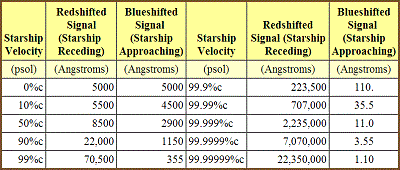 |
|
Problems at higher speeds. Two distorting effects Aberration and Doppler Shift |
Without some means of navigational control, any interstellar transport system is useless. As we shall see presently, relativistic starship navigation is hardly a trivial affair.
At only 1-10%c there are few problems. Just set the crosshairs on the target star, the home star, and three reference stars to either side, and the ship’s navigator can calculate velocity and heading fairly exactly. Problems begin to crop up at higher speeds, however. Two distorting effects begin to dominate: Aberration and Doppler Shift.2745,1160
|
Aberration of starlight Click for Synopsis
|
| Aberration |
Aberration causes stars to appear to be displaced forward into the direction of flight. The situation is analogous to raindrops streaking the windows of a speeding train. Although we know the rain is falling straight down, the streaks on the window run diagonally, slanting downward from the front as if the source was ahead rather than above. Aberration of starlight, similarly, causes stars to appear farther forward than they really are. At relativistic velocities the effect can be extreme. As the speed of light is approached, stars will appear to move to the front and huddle together in a small patch directly in the line of flight. The rest of the sky is black.
|
Doppler Shift of starlight Click for Synopsis
|
| Doppler Shift |
Doppler Shift applies to light as well as sound. The changing pitch of a moving siren as it passes the listener is an example of this effect. On board a starship, Doppler Shift will blue-shift light from approaching stars (looking forward) and red-shift light from receding stars (looking astern). So suns ahead of the vessel in the line of flight will become bluer in color; those behind will become redder.
At 37%c, a starship leaving Sol would no longer be able to see it. Sol’s light, severely red-shifted, would have moved into the infrared and would be invisible to human eyes. If the destination is Alpha Centauri that star would also be invisible, having been blue-shifted up into the ultraviolet range.
As velocity increases still more, a growing zone of darkness appears directly sternward. It grows larger as the ship picks up speed. A similar patch of starless blackness develops toward the bow. At 50%c, the cone of invisibility distends an angle of 30° forward and more than 60° astern. The only stars that are still visible are crammed into a "barrel" surrounding the starcraft. The forward rim of the Star Barrel is seemingly dominated by brilliant blue-white stars. Sweeping the eye upwards and rearward, the hue of star light changes from blue to green to yellow to orange to red, then to blackness. All the familiar constellations are compressed and distorted beyond recognition.
Mounting speed forces the Barrel slightly backwards, then forward again, compacting still narrower with even more vivid coloration. The Barrel has now become what Eugene Sänger once called the Starbow.2783 At 99%c the Starbow, now an annular rainbow-hued ribbon of color leading the spacecraft, is 12° wide with its forward edge raised up 23° from the line of flight. The rest of the sky it jet black. Precise navigation by external fixes has become utterly impossible, and the starship pilot must rely on a system of dead reckoning or inertial guidance.
|
Starship communication Click for Synopsis
|
| Starship communications |
Communications between starship and home planet become problemmatical as the vessel moves off at relativistic speeds. Not only will there be a growing time delay due to rapidly increasing distance,1091 but the frequency of the signals received will be altered. If the communication system uses laser transmitters tuned, say, to monochromatic green light at exactly 5000 Angstroms, then the changes in frequency at the receiver are as shown in Table 17.5. A receding starship sees the green light as infrared for speeds above 50%c, and at excessive suboptic velocities as microwaves. Conversely, an approaching vessel sees ultraviolet signals above 50%c and x-rays above 99.9%c.
| Other interstellar navigation hazards |
There are many other hazards to interstellar navigation which we can only briefly mention here.
- Relativistic starcraft will be subject to radiation damage and erosion caused by the impact of interstellar dust and hydrogen atoms.2761
- Besides irradiation of the crew, there will be extreme heating effects on the starship forebody at near optic speeds — without magnetic shielding, forebody surface temperature could reach 3010 K at 99.9%c in a 1 atom/cm3 interstellar medium.1116
- Besides the possibly devastating effect of even grain-sized meteorites, Oort Belts of from 1012-1015 cometary objects in the plane of the planetary system must be avoided by choosing superecliptic approach trajectories when entering alien stellar systems.2038
- There is also the possible problem of encountering unnavigable "starfog" in dense galactic gas clouds.2885
- The danger of running into unbuoyed free-wandering black holes and neutron stars is ever-present.22
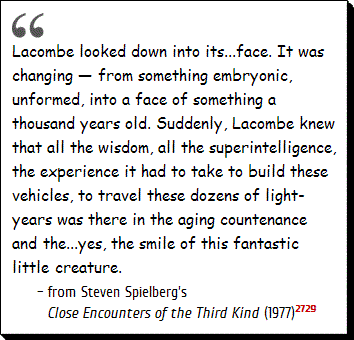 |
Citing the tremendous difficulties involved in high speed interstellar journeying, many writers have turned in desperation to the concept of the "generation ship" or "interstellar ark."*
- These mammoth vessels would contain self-sufficient communities of the sentient spacefaring species and their offspring.2759
- Farfetched, sophisticated space drives would be unnecessary, since the revolving crew could tolerate trips lasting hundreds of years to the nearer stars.
- While the original explorer-colonists might never live to see the New World, their great-grandchildren and successive generations would survive to carry the great mission on to its conclusion.
| Social and genetic backsliding |
Science fiction authors have described the social and genetic backsliding that could occur in such closed ecologies.2794
- The degree of discipline that each individual would have to accept would be more demanding than that of any present totalitarian regime here on Earth.
- Birthrates must be strictly controlled, psychological interactions skillfully managed, epidemiological and eugenics rules absolutely enforced.
- All aberrant ship-threatening behavior severely punished.
- From the human point of view the restrictions on personal freedom would be well-nigh intolerable.
Still, as Dyson points out, "we have no right to impose our tastes on others."2792
* See especially Bernal,2820 Clarke,2789 Gelula,2790 Haldeman,2839 Heinlein,2854 Macvey,732 Panshin,2579 and Strong.50
|
The generation ship would provide a pathway |
The generation ship would provide a pathway to the stars for any patient extraterrestrial species that either could not or would not build relativistic propulsion systems.
- Speeds from 1-5%c should be ample to commute between neighboring star groups in periods of only a few centuries.
- This can be done using relatively primitive space hardware.
- Our own Pioneer 10 probe, which departed the solar system a few years ago, is now heading out into the interstellar void at 0.004%c — a respectable velocity, considering that the craft was designed solely for interplanetary travel.
Of course, during the long journey the technology of the home planet will not stand still. In more than one science fiction story, the crew of the first interstellar ark arrives at their destination only to find that they had been passed many times en route by superior starcraft of more modern design, and that the target system had long since been colonized by others.2791 James G. Strong suggests that "such action will only arouse bitterness among the pioneers, and it would be kinder to avoid their destination — certainly never to come within hailing distance of their ship."50
|
Like the interstellar ramjet that picks up its fuel
along the way, an "Ark runway" would enable a generation ship to pick up supplies positioned earlier across its flight path by unmanned cargo vessels dispatched from the home planet. |
| Ark runway |
Note that there is no absolute requirement that the full complement of consumables be carried on board the Ark at launch. According to C.A. Cross, "its materials balance could be sustained by the return to it of unmanned vehicles carrying raw materials on long stern chase trajectories."2793 Like the interstellar ramjet that picks up its fuel along the way, an "Ark runway" would enable a generation ship to pick up supplies positioned earlier across its flight path by unmanned cargo vessels dispatched from the home planet.
|
Sea voyages of this length were common
among sailors and traders of centuries past: 2 years, Sir Francis Drake’s 3 years, and Marco Polo’s excursion to China totaled 24 years. |
| Immortal astronauts |
There are several other alternatives to the generation ship.
As Freeman Dyson once remarked:
"Interstellar travel is essentially not a problem in physics or engineering but a problem in biology."
- For instance, if medical science can learn how to prolong life indefinitely and create immortal astronauts, then the crew which began a lengthy voyage would live to see the end of it.
- The perspective of immortal beings would doubtless be quite farsighted, and it is not unreasonable to suppose that such creatures would have a leisurely, relaxed outlook on life.
- A century or two spent out of a 2000 year lifespan would seem no more painful than a 3-7 year voyage would to a human.
- Sea voyages of this length were common among sailors and traders of centuries past: Magellan’s global circumnavigation required 2 years, Sir Francis Drake’s 3 years, and Marco Polo’s excursion to China totaled 24 years.
| Sleeper ship |
Another possibility is the "sleeper ship," a well-worn science fiction theme during the last half-century.
- There are basically three classes of sleepers: Ectogenetic astronauts (discussed in the previous chapter), hibernauts, and cryonauts.
- Hibernauts are starship crew members whose metabolisms have been greatly slowed. Like bears, woodchucks, bats and many rodents, these interstellar travelers would "hibernate" for most of the trip.
- For starfaring hibernauts, objective centuries would melt into subjective hours, creating a delightful illusion of near-instantaneous travel.
- Experiments with small mammals here on Earth indicate that it may be possible to induce artificial hibernation in humans using a variety of specific metabolic inhibitors such as the antabolone found in aestivating lungfish.2785
- The addition of antabolone to other anti-metabolic ingredients should permit metabolism to be reduced to 1% of normal at temperatures near 0 °C.
- Hibernation for extended periods should be possible, although as in natural hibernation it will probably be necessary to periodically raise the temperature to normal for a few hours each month to allow certain cellular restorative functions to take place.67
| Cryonauts |
Cryonauts are interstellar travelers whose bodily functions have been entirely shut down. Placed in "suspended animation" at cryogenic temperatures, these starfaring passengers cross the Galaxy in compact, refrigerated vessels equipped with ultrareliable supercomputers designed to patiently wait out the lonely centuries and then automatically reanimate the frozen travelers when the target star system is reached. Robert Prehoda, a science writer and technology forecaster, speculates that:
Cryonauts may travel for many centuries between the stars in fully automatic self-repairing spacecraft controlled by immortal super-computers — descendants of "HAL" in 2001, A Space Odyssey. When they are revived, the journey will seem to have been only one night long. perhaps they will stay alert for a few years to explore new planets and transmit information about them back to Earth. Then they could be frozen again for another mission to a more distant star, repeating the freeze-revive-freeze cycle several times before circling back to Earth after an odyssey of many millenia.67
Suspended animation will require only a modest-level biotechnology, in all probability.
- The main problem with freezing organic tissues is the extracellular formation of ice crystals which cause tissue damage, making reanimation impossible.
- Nevertheless almost every kind of mammalian tissue has already successfully been frozen and thawed under appropriate conditions.3697
- For instance, rabbit skin has been frozen to -196 °C in liquid nitrogen for 7½ months and is still viable when thawed.2786
- Successful freezing and thawing of rat pancreas cells down to -196 °C has been shown.2788
- Rat heart tissue can be reanimated after indefinite storage in liquid nitrogen.1687
- Low temperature preservation of human blood cells, sperm and ova is now routine.
| Whole-organ freezing |
Whole organs have also been reanimated, though this is more difficult
- Marshal Shlafer and Armand M. Karow, Jr. successfully restored isolated rat hearts cooled to -30 °C and perfused with a commonly-used biological antifreeze called "dimethylsulfoxide," or DMSO.1685,1692
- Dr. Isamu Suda of Kobe University in Japan froze a whole cat brain to -20 °C for more than 6 months using a DMSO cryoprotectant perfusate. After thawing, the brain was shown to have nearly normal electroencephalic wave tracings.3694,3695
| Whole-body freezing |
What about whole-body freezing?
- Many experiments during the past few decades have demonstrated that laboratory rats can be cooled to -10 °C and later restored to life in apparently normal condition.
- However, the period of "cold sleep" must not exceed a few hours and no more than 50% of the body fluids may be solidified.2787
- Lower lifeforms are much easier to freeze.
- Nematode worms, for example, survive suspended animation at liquid nitrogen temperatures indefinitely when subjected to a specific DMSO perfusion treatment.1689
| Whole-human freezing |
What about whole humans?
- The well-known mammalian diving reflex, together with the body’s lowered oxygen needs at temperatures close to freezing, have permitted people to survive drownings in icy river waters during literally hours of submersion.
- Dr. Ivan W. Brown, Jr. of Duke University Medical Center has successfully revived a human child whose body-temperature was reduced to 5 °C.67
Following the successful cryopreservation experiments on dog kidneys performed by Dr. M.D. Persidsky at the Institute of Medical Science in San Francisco and Ronald Dietzman of the University of Minnesota, Robert Prehoda has tentatively suggested a hypothetical medical procedure for placing human beings into a state of reversible suspended animation:
The body temperature is lowered to 0° C and a heavy water (D2O) perfusate now circulates through the body. Soon most of the H2O molecules have been replaced with D2O. A 5%-by-volume addition of fluorinated DMSO is now added to the perfusate. This chemical will partially protect the cells during freezing, but its main function is to act as a biological carrier, insuring that the powerful metabolic inhibitors will reach adequate levels within all the cells. Salt-free albumin and ATP are added to the perfusate, allowing the level of dissolved salts within the cells to be reduced. The pressure is greatly increased, and large quantities of dissolved xenon gas begin to be circulated through the body. The fluid-filled cavities around the brain, spinal cord and in the eyes are properly protected by separate perfusion systems.
The heavy-water-based perfusate is replaced with a liquid fluorocarbon which can hold large quantities of dissolved xenon. The pressure is slowly raised as the temperature is reduced. At 5000 psi, an optimum quantity of xenon can be perfused through the body, thoroughly penetrating every cell. No more xenon is needed. The pressure is slowly increased to 30,062 psi. The perfusate pump is shut off. The body temperature is -24 °C. The pressure is then lowered to 5000 psi and rapid solidification begins to take place through the body. Cooling continues as the pressure is again increased to 30,062 psi, allowing the heat of fusion energy to be dissipated. The up-and-down pressure cycle is repeated four more times during continuous cooling, permitting the body to be uniformly frozen. Xenon hydrate protects every cell against freezing damage. The body temperature continues to be lowered at a controlled rate until it is only 4.2 degrees above absolute zero — the temperature of liquid helium.
You are now in a state of complete suspended animation.67
|
Prehoda estimates that the natural decay of
radioactive isotopes in body tissues will cause a lethal accumulation of radiation damage in human cryonauts in roughly 35,000 years. |
These steps may be followed in reverse order to achieve reanimation.*
| Radioactive isotope decay |
Cryonauts may not be immortal.
- Every minute 106 atoms of radioactive K-40 and 2 × 105 atoms of C-14 decay in a human body, spraying bones and organs with beta particles and other low-level radiation.
- Accumulation of trace amounts of radionuclides is virtually inevitable for any carbon-based lifeform, and these minute natural emissions may produce genetic mutations and other irreversible cellular damage over millennia of cold storage.
- Prehoda estimates that the natural decay of radioactive isotopes in body tissues will cause a lethal accumulation of radiation damage in human cryonauts in roughly 35,000 years.
- This difficulty can perhaps be avoided by raising potential astronauts from birth in a carefully controlled radiation-free environment.
- Food, water, and air must be purified and made free of the harmful isotopes.
- This accomplished, cryonauts should last for millions of years in suspended animation (assuming adequate shielding from the cosmic ray background) and would be prime candidates for long-term low-velocity galactic exploratory and colonization missions.
| Cryonics Societies |
* Already about fifty people have been frozen, using somewhat more primitive perfusal techniques, by several Cryonics Societies around the country. These methods may not prove successful, but we won’t know for sure until reanimation is attempted on one of the many frozen patients, perhaps a century from today.
